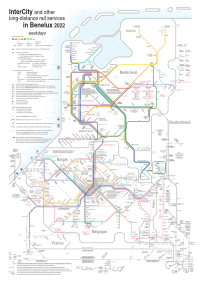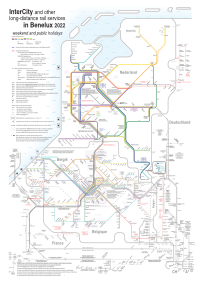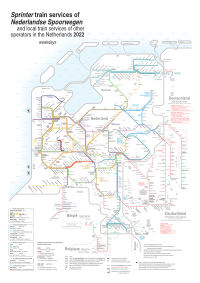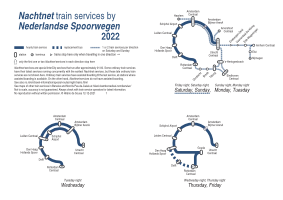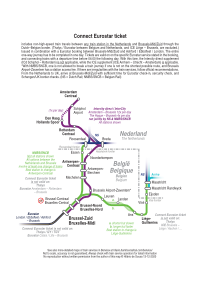Please buy me a coffee/tea! ☕
As you can see, these pages have not been updated for 2023. Things are slightly different, but not too different from the situation in 2022. I will make updates for 2024!
Travelling around the Netherlands by train
Greetings! Here are some tips on travelling by train in/to/from/through the Netherlands. See also the home page for tips on train travel in Benelux in general; not all tips on the Netherlands in that page are repeated here.
The Netherlands is known as Nederland in Dutch, Nederlân in Frisian, Niederlande in German, and Pays-Bas in French. This is the Netherland's governmental website, and tourism website. The Netherlands is also commonly referred to as Holland in many languages (e.g. Hulanda in Papiamento, Holland in Luxembourgish), when in fact Holland is just one region of the Netherlands (albeit the most properous region, nowadays the provinces of North Holland and South Holland). For branding purposes, the Netherlands do sometimes call itself Holland.
Here we will only talk about European Netherlands; the Netherlands also includes Caribbean Netherlands: Bonaire, Sint Eustatius, and Saba. Further up in governance is 'The Kingdom of the Netherlands', which includes the contituent countries of the Netherlands, Aruba, Curaçao, and Sint Maarten.
Jump to:
- Passenger rail service operators
- Types of train services
- Ticketing matters
- Breaking, detours, and fares
- Accessibility issues
- Other public transport operators
- Train deals with Germany and Austria
- Train deals with Belgium and Luxembourg
- Train deals with England and France
- Tourist railroads
- Disclaimer
Passenger rail service operators
A number of companies run passenger rail services in the Netherlands. The following are the Dutch operators of non-high-speed and semi-high-speed trains:
- NS Nederlandse Spoorwegen 'Dutch Railways' (domestic website, android, iOS; international website, android, iOS): the Dutch national railway company; runs the majority of trains in the Netherlands.
- Intercity direct (ICd) is a semi-high-speed service within the Netherlands. For domestic travel, there is a surcharge on the Schiphol – Rotterdam high-speed line on top of normal domestic train fare (see below). International ICd is an extension of the domestic ICd service to Belgium: this Amsterdam – Brussels semi-high-speed service is run together with NMBS/SNCB (Belgian Rail; domestic website, android, iOS; international website, android, iOS).
- The Amsterdam – Berlin InterCity service is run together with DB (German Rail; website, android, iOS). Domestic trips on this service within the Netherlands has normal NS ticketing. Seat reservation is not possible for trips within the Netherlands. InterCity services in Benelux have the same pricing as local train services, unlike Germany.
- NS also runs the Gouda – Alphen aan den Rijn line for R-net, a public-transport brand of the regional governments in western Netherlands. The Gouda – Alphen aan den Rijn line follows normal NS ticketing rules.
- Qbuzz: primarily a bus company, runs the Dordrecht – Gorinchem – Geldermalsen train service, as part of the R-net network. Qbuzz is a subsidiary of Busitalia, part of Ferrovie dello Stato Italiane, owned by the Italian state.
- Arriva: subsidiary of DB. Runs many regional trains in the east and north of the Netherlands. Dutch Arriva trains and ticketing extends into Germany at: a) Weener and Leer (Ostfriesland) in the north (RB 57. The railway bridge between Weener and Leer collapsed; replacement buses to/from Leer will run for some more years); and b) Herzogenrath, Aachen West, and Aachen Hauptbahnhof in the south (RE 18).
- Breng: subsidiary of Connexxion, primarily a bus company, runs additional train services between Arnhem Centraal and Doetinchem, in parallel with Arriva's Arnhem Centraal – Doetinchem – Winterswijk service in eastern Netherlands. Follows Arriva's ticketing rules for this line.
- Valleilijn: the Amersfoort – Ede-Wageningen train line is run by Connexxion, subsidiary of Transdev.
- Blauwnet: public-transport brand of the province of Overijssel in eastern Netherlands. Trains run by Arriva (Zwolle – Emmen, Almelo – Hardenberg), or Keolis Nederland (Zwolle – Kampen, Zwolle – Enschede, Zutphen – Oldenzaal). Keolis is majority owned by SNCF (French Rail).
The following are the German and Belgian operators with non-high-speed trains running in the Netherlands:
- Eurobahn/Keolis Deutschland: Hengelo – Bielefeld Hauptbahnhof (RB 61), Venlo – Hamm (Westfalen) (RE 13). The Hengelo line has two stations in the Netherlands: Hengelo, and Oldenzaal. Domestic travelling within the Netherlands has the same ticketing rules as the Blauwnet Zutphen – Oldenzaal line. (The Venlo line has no domestic sections in the Netherlands.)
- DB Regio NRW: Enschede – Gronau – Münster (Westfalen) Hauptbahnhof (RB 64), Enschede – Gronau – Dortmund Hauptbahnhof (RB 51). The Enschede lines (RB 64, RB 51) have three stations in the Netherlands: Enschede, Enschede De Eschmarke, Glanerbrug. Domestic travelling on this line in the Netherlands has the same ticketing rule as the Blauwnet Enschede – Zwolle line. Dutch OV-chipkaart can be used in Gronau, the first station on the German side of the border.
- VIAS: Arnhem Centraal – Düsseldorf Hauptbahnhof (RE 19). This line has two stations in the Netherlands: Arnhem Centraal and Zevenaar. Domestic travelling on this line in the Netherlands has the same ticketing rules as the Arriva Arnhem Centraal – Winterswijk line. Dutch OV-chipkaart can be used in Emmerich-Elten, Emmerich am Rhein, and Praest stations in Germany.
- NMBS/SNCB (Belgian Rail) runs two of its own local train services into the Netherlands: Maastricht – Liège-Guillemins (– Hasselt), and Roosendaal – Antwerpen-Centraal – Puurs. The Maastricht Line has three stations in the Netherlands: Maastricht, Maastricht Randwyck, Eijsden. Domestic travelling in the Netherlands follows NS ticketing rules. (The Roosendaal Line has no domestic sections within the Netherlands.)
The following are the high-speed rail service operators:
- Thalys (Amsterdam – Schiphol – Rotterdam – Antwerp – Brussels – Paris, seasonal trains to Bourg Saint-Maurice). Thalys has its own ticketing. The two largest shareholder are SNCF and NMBS/SNCB.
- Eurostar (Amsterdam – Rotterdam – Brussels – (Lille –) London). Eurostar has its own ticketing. The majority shareholder of Eurostar is SNCF.
- ICE International (Amsterdam – Utrecht – Arnhem – Oberhausen – Duisburg – Düsseldorf – Cologne – Frankfurt Airport – Frankfurt/...Basel). Domestic travel on the ICE within the Netherlands requires just normal domestic ticketing, plus an ICE supplement (see below) for some people. International travel and domestic travel within Germany follow German long-distance ticketing. ICE International is a consortium between NS and DB that runs the Netherlands – Germany and Belgium – Germany ICE services.
The following runs sleeper trains:
- Nighjet of ÖBB (Amsterdam – Vienna/Innsbruck, Amsterdam – Zürich). ÖBB has its own ticketing.
Types of train services
Video taken in 2018:
Based on their stopping patterns, there are the following types of train services:
- Sprinter (term used by NS and Keolis), RS (by Arriva), or Stoptrein: primarily all-stops services. In rare cases they skip one or two stops. The term Stoptrein now only applies to the Zutphen – Oldenzaal services, and the Dordrecht – Gorinchem – Geldermalsen services, but the other all-stop services may also be referred to as Stoptrein informally. Sprinter / RS / Stoptrein is analogous to RB in Germany and Luxembourg, and L or S in Belgium. (Note that Sprinter in the Netherlands refers to all-stop services, very different from ICE Sprinter in Germany which is the fastest rail service possible with the least number of stops.)
- RE: a rarely encountered intermediate category, stopping at medium and large stations. Amongst Dutch companies, RE's are only operated by Arriva, and they are all run in parallel to the RS services on the same line. RE's are sometimes informally referred to by the older term Sneltrein. From north to south:
- RE 1 Leeuwarden – Groningen
- RE 6 Groningen – Windschoten (peak service)
- RE 20 Zwolle – Coevorden – Emmen
- RE 20 Zwolle – Coevorden (– Emmen) (peak service)
- RE 30 Apeldoorn – Zutphen (– Winterswijk) (evenings and weekend)
- RE 18 Maastricht – Heerlen (– Aachen Hbf)
- InterCity (IC): usually only stops at the major stations. On certain sections it can become an all-stop service, especially towards the end of a line. All domestic InterCity services are operated by NS, except the Zwolle – Enschede IC service operated by Keolis. The Amsterdam – Berlin InterCity service is operated jointly by NS and DB.
- Intercity direct (ICd): semi-high-speed service. Domestic ICd Amsterdam Centraal – Schiphol Airport – Rotterdam Centraal (– Breda) is operated by NS, International ICd runs further from Breda to Brussels, and is operated jointly by NS and NMBS/SNCB.
- High-speed services:
- ICE (Intercity-Express): between Amsterdam and Frankfurt/Basel
- Thalys: Amsterdam – Brussels – Paris, seasonal services to Bourg St. Maurice
- Eurostar: Amsterdam – Rotterdam – Brussels (– Lille) – London
- Sleeper service: ÖBB Nightjet Amsterdam – Vienna/Innsbruck, Amsterdam – Zürich
The following are network maps of the regular passenger rail services in the Netherlands.
InterCity and high-speed rail network in Benelux:
Local train network in the Netherlands:
Nachtnet services are domestic InterCity services that run between approximately 00:00 till 05:00. Utrecht – Amsterdam – Schiphol Airport – The Hague – Rotterdam are linked every night. During the weekend (Friday–Saturday and Saturday–Sunday nights) there are one or two Nachtnet services to certain other cities. Other than Nachtnet, many ordinary trains also run till some time pass 00:00, or even 01:00 (see, e.g., this). One difference between these ordinary services late at night and the Nachtnet services is that the ordinary services get assisted boarding service till the last train (at stations where this service is available), whereas Nachtnet services has no assisted boarding service. Nachtnet services have the same ticketing as the other NS services. Tickets are valid for services with a scheduled departure time, at the station where you board the train, before 04:00 the day after the date printed on the ticket. For instance, with a ticket dated 28-05, the last train that you can catch is a train with a scheduled departure time of 03:59 on 29-05 at the station where you board that train.
Nachtnet in the Netherlands:
You may be interested in the printed timetables of the domestic and international train services in the Netherlands. (The information in these printed timetables is not necessarily up to date; always check with NS for the latest information. NS no longer publishes printed versions of the spoorboekje; printed versions by Rover/Treinreizigers.nl can be found here.)
Ticketing matters
There are two main types of tickets: e-ticket, which comes with a barcode, and OV-chipkaart, which is an NFC card (contactless).
E-tickets
E-tickets are tickets bought from the websites or apps of the public transport providers. For trains, the defaults are:
The NS domestic website/app sells tickets for all domestic train journeys, including trains that are not run by them. The websites/apps of the other public transport providers also sell products that are specific to them. There are also the following apps, where they sell train e-tickets tickets and other transport services (they all have their specialities, and sometimes discounts specific to their app):
- Gaiyo (android, iOS)
- Glimble (a href="https://play.google.com/store/apps/details?id=com.arriva.glimble" target="_blank">android, iOS)
- Tranzer (android, iOS)
E-tickets have a barcode. For single and return tickets, you have to provide travel details like the 'from' and 'to' stations (NS no longer lets you nominate a 'via' station when issuing domestic tickets), date, single/return (for domestic tickets, return is within a day), class of travel (first/second class), and number of passengers (1 to 9 or 10 passengers). Other than travel details, you also have to provide personal details of all the travellers, like name and date of birth (the ticket can only be used by the person/people named on the ticket). Many e-tickets bought from the domestic NS website or the NS International website can have the E-ticket loaded to their respective app. Otherwise, an e-ticket has to be printed out on a piece of A4 paper. When using an e-ticket, you have to be able to show an ID if asked. The name on the ID and the name on the ticket have to match. Acceptable IDs are passport, national ID card, and driver's licence (the latter two probably refer to European ones).
If the e-ticket is not automatically loaded into an app, then you will be given a code after payment. You would then need to redeem (verzilveren in Dutch) the e-ticket from the NS website. One tip is that, if you have to print the e-ticket out, e-tickets can be redeemed at the Self-service corners at some NS International offices. (But be mindful that the computer and/or printer could malfunction, and the queues could be long, so be flexible time-wise.)
The domestic NS website and app do not give discounted e-tickets for the normal single/return train tickets. On the other hand, with the NS International website and app, they automatically give you a range of available prices. You can also specify railway subscription(s) that you have, and the applicable discount(s) is/are automatically applied (if applicable).
A good deal that can be purchased from the domestic NS website is the off-peak group ticket for 4 to 7 travellers travelling together.
When using an e-ticket, checking in and out at the check-in portals are not required; just walk straight to the trains. If there are closed gates, the barcode can be used to open closed gates at train stations. Not all gates can read e-ticket barcodes, but there is always at least one that can read barcodes at each station with closed gates. (Like other frequently used barcode scanners, the station barcode scanners do not necessarily work very well; you might have to make multiple attempts at scanning the barcode before the gate opens. Or try another gate. Or ask for help.)
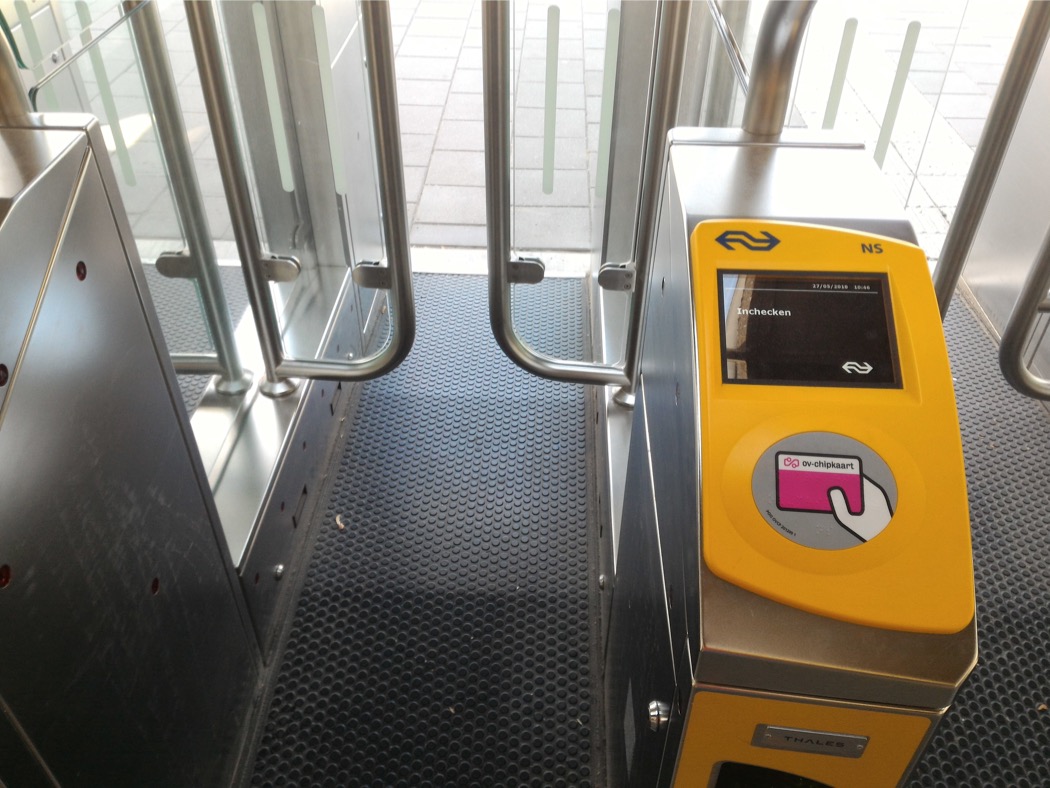
E-tickets from nearby countries to the Netherlands often have a barcode that can open the gates at Dutch railway stations. (Not all stations have gates.) From Germany, some local public transport tickets do not include such barcodes. In some cases, train staff gives out a piece of paper with the required barcode in the train, as the train approaches a Dutch station with gates. In other cases, you can ask the staff at the Dutch train station that your German train arrives at. If stuck, there are information poles near the gates, and you can press the blue i button for help; a staff member will then speak to you remotely. (The other button is a red SOS button for emergencies.) Alternatively, try to seek the attention of a station attendant.
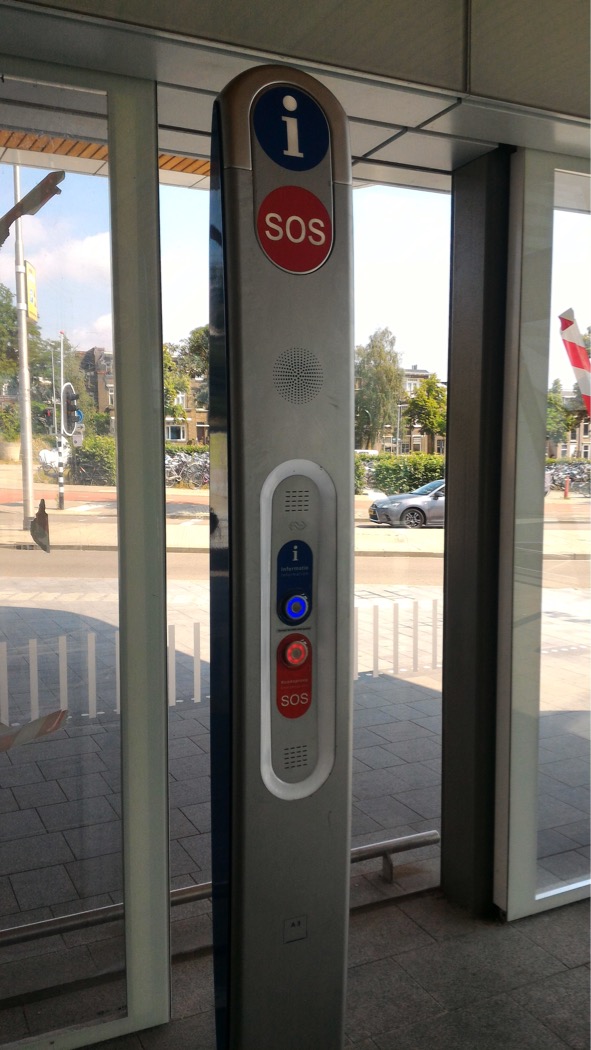
OV-chipkaart
OV-chipkaarts are near-field communication (NFC) cards; you place an OV-chipkaart near the reader within centimetres, the card is then read by the reader, and validated if everything is in order (the reader beeps and shows a green light). There are disposable OV-chipkaarts, and durable OV-chipkaarts.
Disposable OV-chipkaarts, and Dutch Rail ticket machines/ticket counters
Disposable OV-chipkaarts are single-usage tickets issued by train-ticket machines. At ticket counters, all domestic tickets and many international tickets are also issued as disposable OV-chipkaarts.
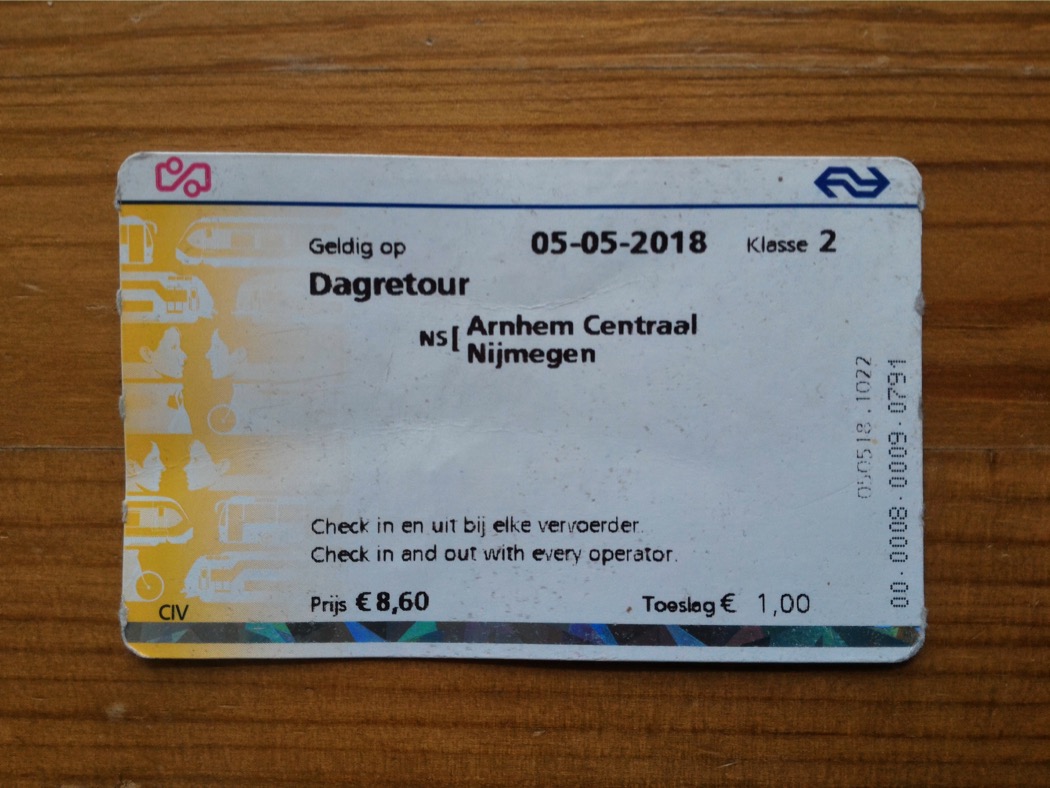
NS has three types of ticket machines. Only the usual ticket machines – the ones that are blue at the top with a white NS logo – sell disposable OV-chipkaart tickets. They also sell durable OV-chipkaarts. (The other two types are for people who already possess durable OV-chipkaarts.)
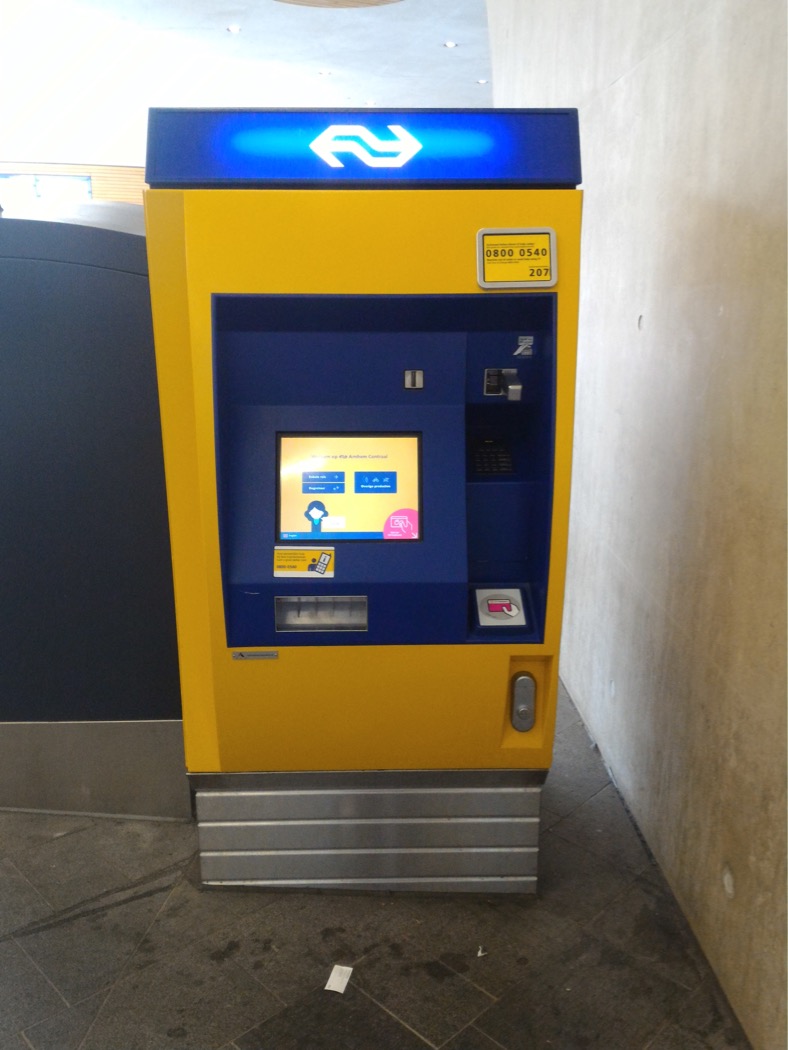

You can get tickets between any train stations in the Netherlands from NS ticket machines, even on train services run by other Dutch/German/Belgian train companies in the Netherlands (excluded are Thalys, Eurostar, and Nightjet). The Arriva ticket machines also sell tickets between any train stations in the Netherlands, also in the form of disposable OV-chipkaarts.
NS ticket machines and the normal NS ticket counters sell the same range of single/return tickets. They also charge the same ticket-issuing fee. For domestic single/return tickets, the issuing cost of a disposable OV-chipkaart is €1 per card, which is added to the normal ticket price. This €1 fee does not apply to, e.g., Railrunner (child ticket), bicycle ticket, dog ticket, ICE supplement, ICd supplement, Euregio ticket (for the NL/BE/DE tripoint region), and international tickets. The NS ticket machines and the normal NS ticket counters can handle tickets to many destinations in Belgium and Luxembourg, and some closer-by destinations in Germany plus Berlin (see here for a list of possible destinations). The machines no longer offer tickets to the Belgian Rail destinations in France. As for high-speed-rail tickets, they can only print ICE tickets to destinations along the ICE line to Frankfurt (no seat reservation), and they cannot handle Thalys or Eurostar tickets. The ticket machines and the normal ticket counters only offer full-fare tickets! (It is better to purchase tickets – especially international tickets – online in general.)
Other than the normal NS ticket counters, there are eight NS International ticket offices where you can purchase the full range of international tickets that NS International offers. However, for international tickets that the NS ticket machines cannot handle, the NS International offices charge a service fee of €7.5 per person, to a maximum of €22.50 per booking (except for passengers in wheelchairs, passengers with visual impairment, or passengers above 75 years old). Most NS International ticket offices also have self-service computers where you can make your own booking online through the normal NS International website (no service fee), and print the ticket(s) out.
With an NS ticket machine, you can switch between Dutch and English language. The main screen has three main options: One-way ticket, Day return ticket, and Other products.

When purchasing a domestic one-way/return ticket:
- the most popular 'to' destinations are displayed. If your intended destination is not on the list, you have to key in the first one or two letters of the name of the station, and then a list of stations beginning with those letters will appear. Press the button with the name of your inteded destination. Some destinations are not train stations; they combine train and tram/bus travel. For instance, amongst the 'E' destinations are 'Efteling' (theme park) and 'Eindhoven Airport'; tickets to these include travel on train(s) and connecting bus(es). Not explained in the English page are the 'Arnhem Centraal +Bus' and 'Nijmegen +Bus' options, combining train trip to/from Arnhem Centraal and/or Nijmegen, and Breng buses to/from these stations.
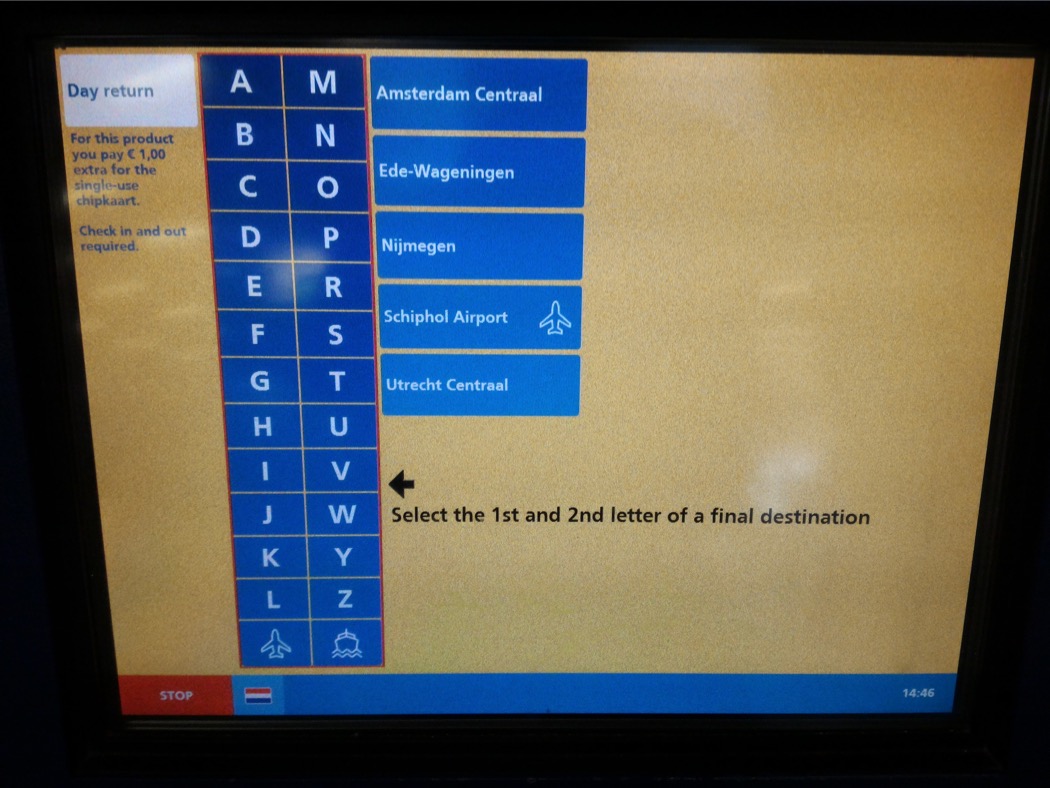
Pressing the 'Day return' button, you get a list of the most frequent destinations (here from Arnhem Centraal), or you can type in the first one or two letters of your intended destination - after the 'to' station is selected, the 'from' station is displayed. The 'from' station is by default the station where the machine is located, but you can also change the 'from' station by pressing the 'from' button.
- choose the date, class of travel (first or second class), and number of passengers. For domestic return tickets, the return journey has to be made within the day. A ticket is valid for trains of which the scheduled departure time, at the station where you board the train, is before 04:00 the following day. If you want to travel after that, you need to buy another ticket.
- pay. Ticket machines DO NOT take banknotes. Some machines take coins. All machines take bank cards and credit cards (V PAY, Maestro, Visa, Mastercard; €0.5 surcharge for credit card). When using cards, the flow of procedures is: insert card, wait, withdraw card when it tells you to, input PIN code, press OK. Then the ticket comes out of the machine if the transaction is successful. (Visa and Mastercard are now accepted at all ticket machines and online. Foreign credit cards seem to work OK. I have seen bankcards from EU but non-Euro countries not working at NS ticket machines.)
For domestic tickets, Dutch ticket machines no longer give a 'via' option. (The NS website/app gives you a 'via' option, but this is only for journey planning; tickets cannot be purchased if a 'via' station is added.) If NS thinks that there are two reasonable routes for your journey, it will list the two options, show you the price difference, and ask you to specify the route you want to take. It also gives you a third option, which is paying the higher price, and it gives you a ticket that allows travelling on either route.
To purchase an international ticket from a ticket machine, the option for purchasing international tickets is embedded within the 'Other products' option at the initial screen. (Alternatively, if you have pressed the One-way or Day return option at the initial screen, you will only discover, after many steps, that these options are only for domestic tickets; a red button for purchasing international tickets will eventually appear in the bottom left corner.)
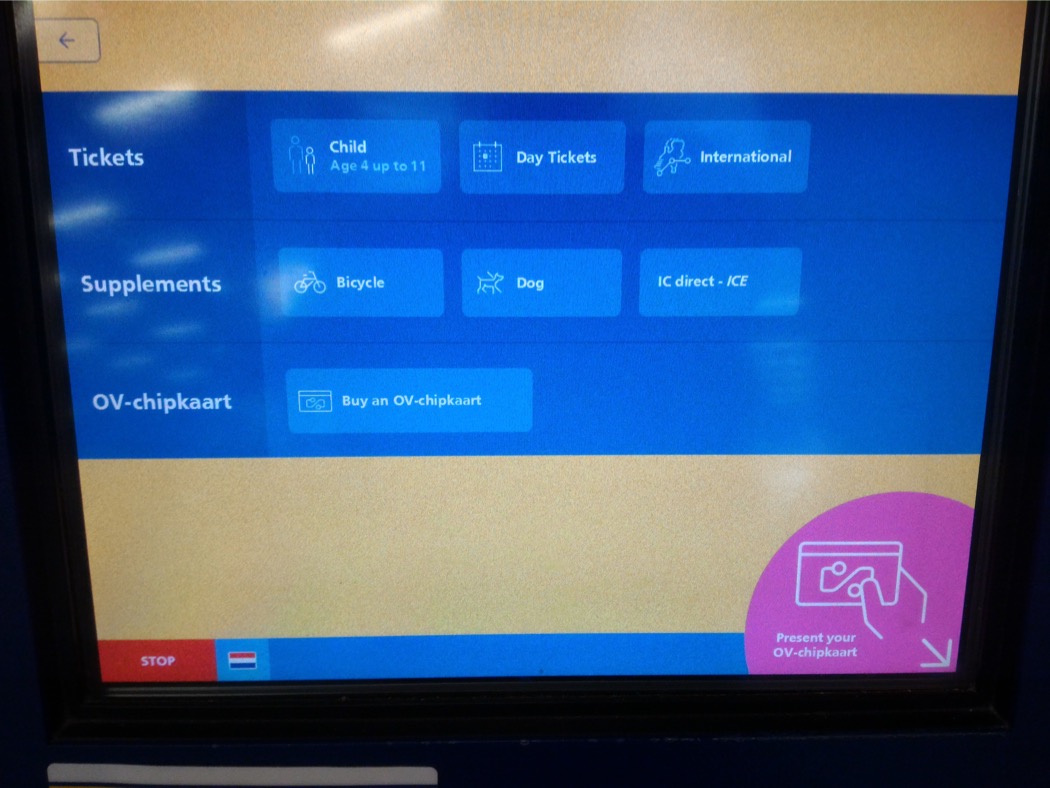
For international tickets, after inputting the 'from' and 'to' stations, a 'via' button will appear, showing you the default frontier point that you cross the border at. If you press the 'via' button', very often it gives you a list of alternative frontier points where you can cross the border, and then it gives you the price for each option. (Non-high-speed international rail tickets always show you the frontier point that you have to cross a border at.)
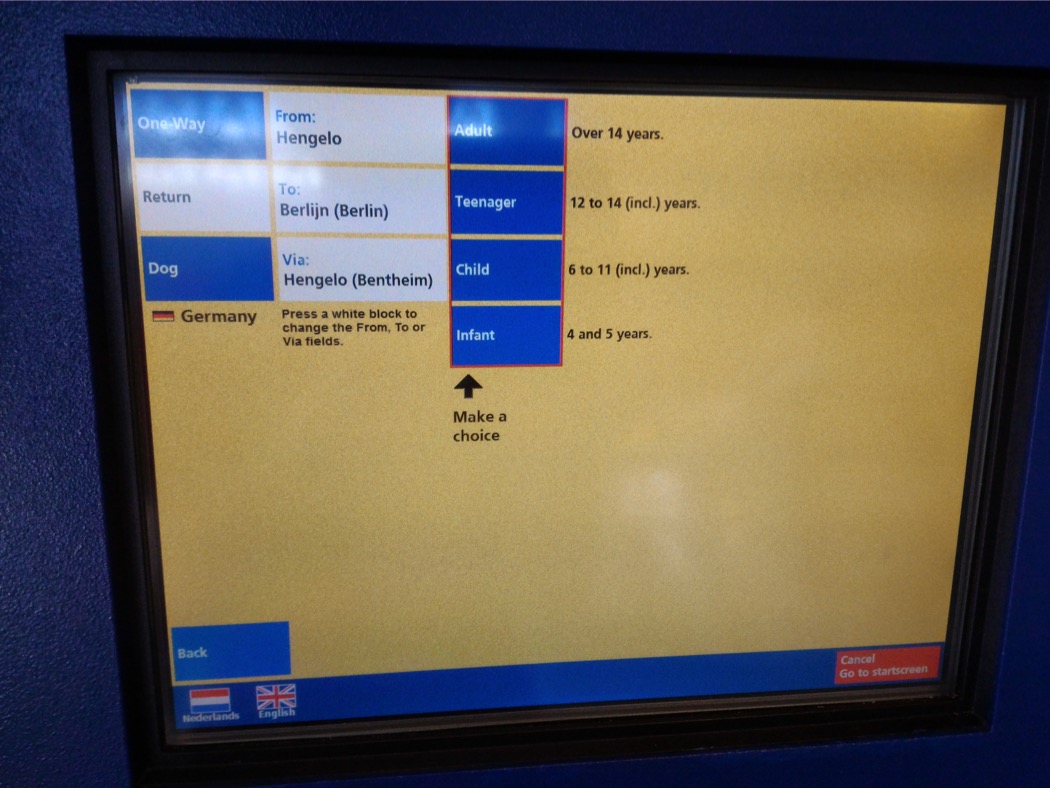
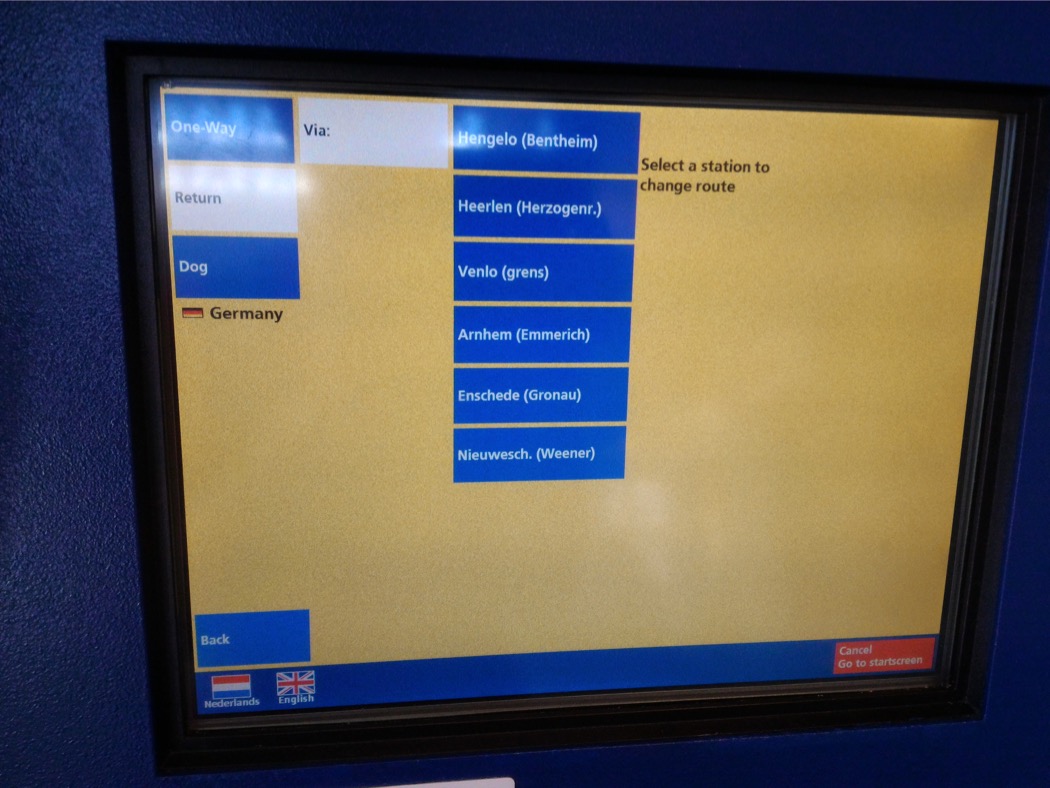
NS ticket machines, and the usual NS ticket counters, no longer give discounted tickets; all tickets, both domestic and international, are full fare tickets. To benefit from samenreiskorting (see below), one needs a durable OV-chipkaart.
On the Valleilijn (Amersfoort – Ede-Wageningen), there are no ticket machines at Hoevelaken and Barneveld Zuid stations! (There are only machines for recharging durable OV-chipkaarts.)
There are German and Belgian train ticket machines at certain Dutch stations near the border. See the Germany and Belgium sections below.
Durable OV-chipkaart
Durable OV-chipkaarts are valid for five years. For regular public transport within European Netherlands, they are valid on all regular passenger trains (not Thalys, Eurostar, and Nightjet, but valid on domestic ICE with surcharge), metros, trams, the vast majority of buses, and some ferries. In Germany, they are also valid on the Dutch Arriva trains (and replacement buses) to Weener and Leer, and also to Herzogenrath, Aachen West, and Aachen Hbf. From 1 August 2021, the Dutch OV-chipkaart is also valid on trains between the Netherlands and Gronau. OV-chipkaarts are valid on Dutch-operated cross-border buses (check carefully), except for the following, where it is only valid within the Netherlands: 42 Breskens – Brugge; 44 Heerlen – Aachen; 64 Roermond – Heinsberg. The Dutch OV-chipkaart is also valid on the following German buses: 620 (only when it is running between Weener and Leer); SB58 Nijmegen – Kleve – Emmerich.
Durable OV-chipkaarts are valid for five years. For regular public transport within European Netherlands, they are valid on all regular passenger trains (not Thalys, Eurostar, and Nightjet, but valid on domestic ICE with surcharge), metros, trams, the vast majority of buses, and some ferries. In Germany, they are also valid on the Dutch Arriva trains (and replacement buses) to Weener and Leer, and also to Herzogenrath, Aachen West, and Aachen Hbf. From 1 August 2021, the Dutch OV-chipkaart is also valid to Gronau. OV-chipkaarts are valid on Dutch-operated cross-border buses (check carefully), except for the following, where the Dutch OV-chipkaart is only valid within the Netherlands: 42 Breskens – Brugge; 44 Heerlen – Aachen; 64 Roermond – Heinsberg. The Dutch OV-chipkaart is also valid on the following German buses: 620 (only when it is running between Weener and Leer within Germany); SB58 Nijmegen – Kleve – Emmerich.
There are personal OV-chipkaarts and anonymous OV-chipkaarts. (They don't necessarily look like the ones below.)
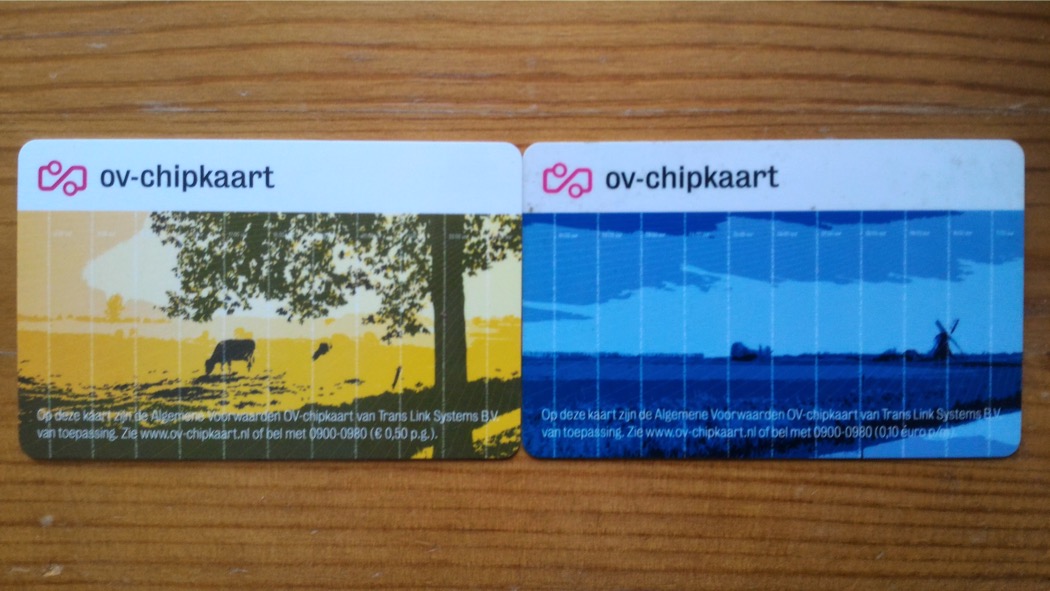
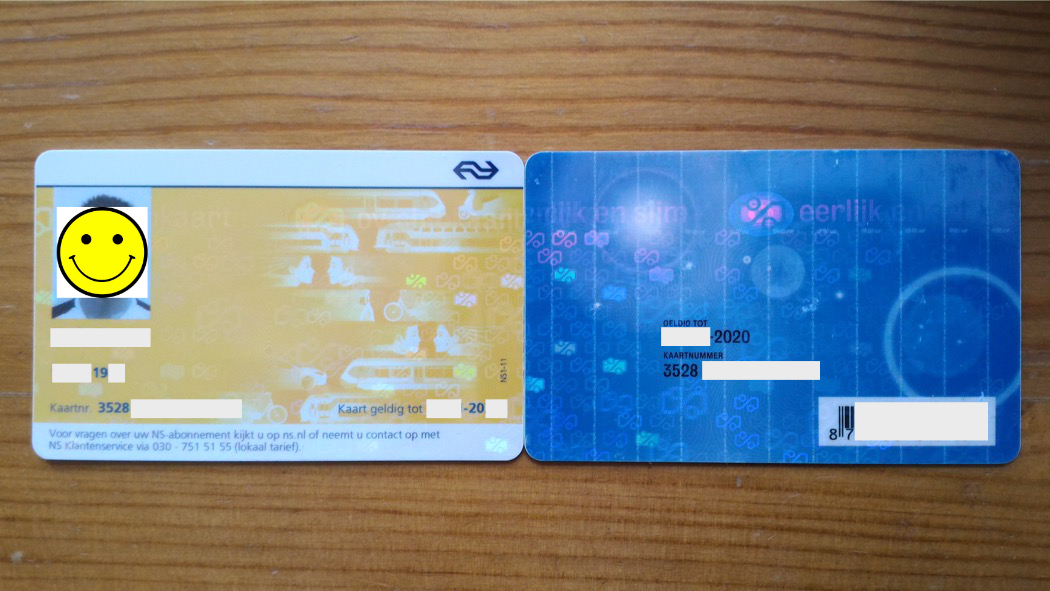
Anonymous OV-chipkaarts can be used by anyone, and the normal retail price is €7.5. (This is just the retail price, not a deposit!) Each OV-chipkaart can only be used by one person at a time; passengers 4 years old or above need their own OV-chipkaart (or another type of ticket). Anonymous OV-chipkaarts are sold at ticket machines, ticket counters, and at some shops (search for OV-chipkaart sales points here). In Germany, they can purchased at: a) the Arriva ticket machines in Weener and Leer in the north, b) the travel centre in Aachen Hbf.
Personal OV-chipkaarts is for one particular person, whose details and photo are printed on the card. A personal OV-chipkaart also costs €7.5, but it is given out for free in some cases, e.g., when you order certain annual NS subscriptions. Otherwise, for people with an address in Benelux or Germany, you can order a personal OV-chipkaart from the OV-chipkaart website.
One functional difference between anonymous and personal OV-chipkaarts is that subscriptions usually require personal OV-chipkaarts. See this page for other functional differences between an anonymous and personal OV-chipkaart.
Credit (i.e. money) can be added to a durable OV-chipkaart through ticket machines of NS, other Dutch railway companies, and many other public transport operators. There are also many free-standing OV-chipkaart terminals (they are usually yellow in colour) where one can add credit to an OV-chipkaart with a bank card. On the internet, one can add credit, or order certain tickets or subscriptions to an OV-chipkaart. However, after an online transaction, one needs to go to a ticket machine, or one of the many dedicated OV-chipkaart terminals, to load the product into the OV-chipkaart. Search here for OV-chipkaart service points.
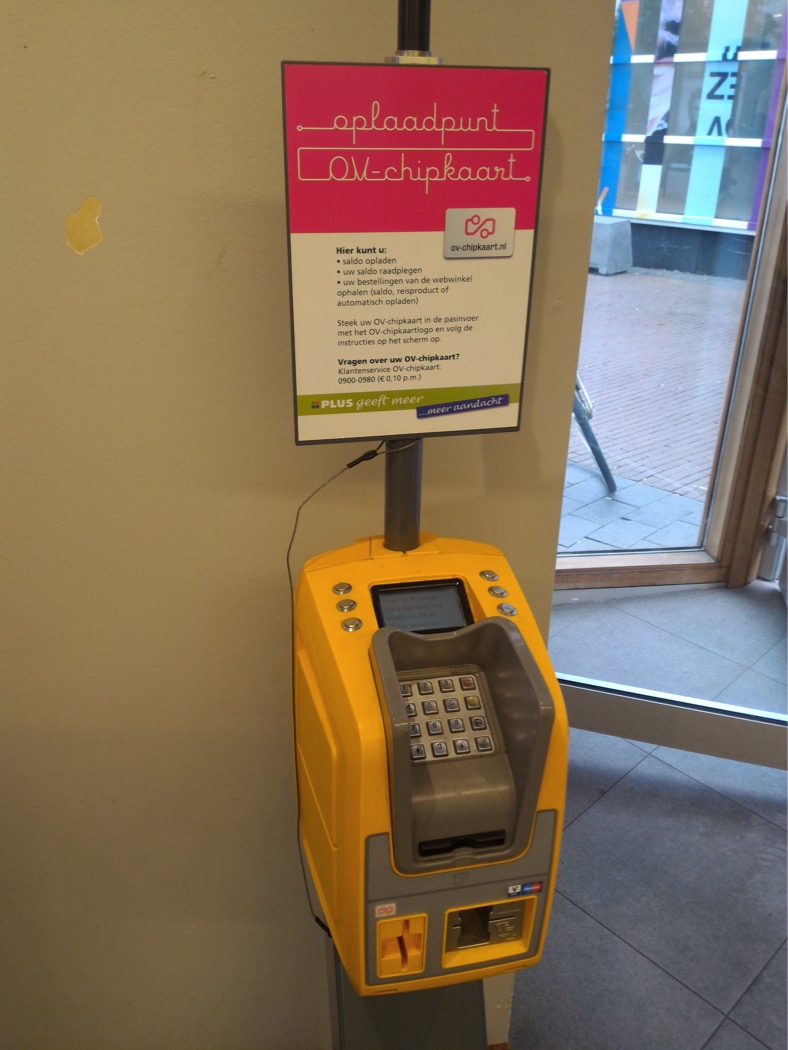
Asking for a refund of the credit in an OV-chipkaart is often not straightforward. An anonymous OV-chipkaart that has not yet expired can have its credit refunded at a service counter of a public transport operator if the credit is under €30.
As one checks in at a check-in portal at a station (or on a tram/bus/ferry), a deposit is deducted from the card. The deposit is between €0 to €20, depending on the public transport company, the type of OV-chipkaart, the subscription(s) that a card has in it, etc. (Without an NS subscription, the deposit for catching NS trains is €20! See here for what the various companies charge for the deposit.) One can only successfully check in if, after the deposit, the credit in the OV-chipkaart is not under negative €4. When one checks out, a refund is given if the fare is less than the deposit, or extra credit is charged if the fare is more than the deposit. However: all NS subscriptions are now post-paid, and the deposit is no longer charged if you travel on trains and if you have an NS subscription. See below.
If you want to change the class of travel temporarily, you can do this at a ticket machine. See this and this. The change expires on 04:00 the following day, unless you cancel it earlier. If you want to change the class of travel permanently, see this, or ask at a ticket office.
With a durable OV-chipkaart, checking out and then back in again at the same station within 35 minutes is consider a transfer. (With a transfer, the flagfall is not charged again. Here we are referring to the flagfall of the train fare, not the check-in deposit.) Take note, that after you have checked out, the balance in the card could have gone too low for the deposit to check in again.
To cancel a check-in, you check out again at the same station within 60 minutes. The deposit is then refunded.
With NS, one cannot check out within 100 seconds of checking-in; this is to prevent passengers from double-tapping the card, accidentally checking out after they have checked in. (You can also use this method to check whether you have already checked in. Another method is to check your travel history at a ticket machine.)
If you have forgotten to check in, try checking in before you step into a train. (In places with open gates, remember to check in on the 'check-in side', i.e. the side that is outside the paid area.) If you are already inside a train, contact the conductor. If not, you risk a fine of €50. (Conductors might be lenient on you if you have a subscription from their company, and if you forgot to check in no more than a few times in a year. In other cases, good luck.)
If you have forgotten to check out, you can go back to the station where you ended your journey and check out there within six hours of the last check-in. If not, go to a service counter of the public transport operator and ask for help. Failing that, try contacting OV-chipkaart. For people with a personal OV-chipkaart or an NS business card, there is a service that, amongst other things, alerts you if you have forgotten to check out.
One can check the credit in a card, or the travel history of the card, at a ticket machine, or at the OV-chipkaart website/app (android, iOS) if the card is linked to an account registered with the OV-chipkaart website.
Abonnementen and 'peak time'
NS and other public transport operators have various abonnementen 'subscriptions' (season tickets) that give discounted or unlimited travel of some sort. When peak/non-peak is referred to, non-peak is most usually 18:30–06:30 and 09:00–16:00 on weekdays, the whole day during the weekend and holidays, and the entirety of July and August. On non-holiday weekdays: a) you can check in with non-peak rate a few (five?) minutes before 09:00 or 18:30, when the non-peak rate officially starts (the departure time of the train itself has to be 09:00/18:30 or later); b) the non-peak rate is valid as long as you check in before 06:30 or 16:00, and the scheduled departure time of the train that you catch is before 06:30 or 16:00 at that station. The non-peak rate remains valid until you leave the system. With NS at least, a transfer within NS (checking out of NS and then back in with NS within 35 minutes) continues the non-peak rate (this is the case since 2016; but then if you check in during peak time, the peak rate would equally be continued with a transfer!)
Note that promotional tickets may require you to leave trains before peak-time begins! Read the terms and conditions carefully.
When shopping for abonnementen 'subscriptions' from websites of public transport operators, the following are common Dutch terms that they use.
- Altijd 'always': the entire day.
- Dal 'valley': during off-peak hours.
- Weekend 'weekend'.
- Vrij 'free': unlimited usage, "all-you-can-eat".
- Korting 'discount' or voordeel 'benefit': you get a discount.
- Jaar 'year/annual'.
- Maand 'month/monthly'.
- Traject 'trajectory': not area-based, but trajectory-based.
- Grens 'border': to/from a railway frontier point where trains cross an international border; this has to be combined with a corresponding Belgian or German ticket/subscription up to the Dutch border.
- OV: openbaar vervoer 'public transport'; when a train company talks about 'OV', they often mean bus/tram/metro.
- Kind 'child'.
- Student 'student', scholier 'pupil', jong 'young', jeugd 'youth' (older than child, younger than adult).
- Keuzedagen 'choice days': for seniors, see here.
- Net: this usually means the entire Netherlands (plus most Dutch public transport that extends into Belgium/Germany)
- Ster 'star': based on the old fare zones, a 1-star abonnement includes the fare zone itself, 2-stars is the fare zone plus bordering fare zones, 3-stars is 2-stars plus their bodering fare zones, and so on until 6-stars. A 7-star abonnement is the same as net, i.e. valid in the entire Dutch bus/tram/metro system. See here or here for the boundaries of the fare zones.
- Gratis 'free/no cost' (for operational reasons, they may have to charge, like, €0.01).
All NS subscriptions are now post-paid; the subscription can be changed on a monthly bases, and you get a bill at the end of your monthly period. See NS Flex. Other than NS Flex, there is also NS-Buisness Card: people with a Kamer van Koophandel (Dutch Chamber of Commerce) number can order NS-Buisness Cards for themselves and their employees. Other than being a post-paid card that works at the usual places where an OV-chipkaart can be used, various subscriptions can be loaded to it.
Other uses of durable OV-chipkaarts
The OV-chipkaart can also be used for some other transport purposes, e.g. bicycle storage at many train stations, renting an OV-fiets (now some of their bikes are opened not by a physical key, but by OV-chipkaart), opening and locking a Greenwheels car. So far I have not seen the OV-chipkaart being used for other purposes, e.g. making purchases at vending machines.
Other forms of NFC tickets
NS has trialled contactless payment with bank cards and credit cards, and NS is satisfied with the results. NS is looking into rolling this out for general use.
NS has also trialled contactless payment with mobile phones with NFC capability, but the results were not satisfactory. There will probably be future trials.
Discounted tickets and 'tourist tickets'
Other than the normal single and return tickets, there are various types of discounted tickets for the normal adult travellers.
If you travel with someone with an NS subscription (other than Kids Vrij), you can travel with them with a 40% discount. This discount is only valid if you travel during off-peak. This can be purchased as a mobile ticket or a printed e-ticket (Samenreisticket: one way, return). Alternatively, this status can be loaded into a durable OV-chipkaart at a ticket machine (a href="https://www.ns.nl/en/travel-information/traveling-with-the-ov-chipkaart/combined-travel-discount.html" target="_blank">Samenreiskorting). A samenreiskorting status expires 35 minutes after checking out; in other words, a samenreiskorting status is maintained with a succesful transfer. When booking international tickets with NS International (except Thalys/Eurostar), there is an option to apply samenreiskorting, and the discount is automatically applied to the section in the Netherlands off full-fare tickets.
Also travelling only during off-peak, booking four or more days before the travelling date gives you 10 % discount (one way, return). This ticket can be purchased as a mobile ticket or a printed e-ticket.
Another (potentially) good deal is the off-peak group ticket for 2 to 7 people.
There are promotional train tickets from time to time (but you'll need Dutch reading skills). Some are sold through NS' main website or leisure site, while others are sold in coorporation and through other physical or online stores. One place where these various deals are summarised is treinreiziger.nl. After you pay, you receive a code, which you use to redeem the e-ticket from the NS website (they come with instructions, in Dutch). Some e-tickets can be loaded into the NS-app, while others must be printed out. These promotional tickets can be off-peak day tickets on trains, return tickets between prenominated stations, packages including train journeys plus tourist attraction entry, etc. The day tickets and return tickets are around €20. These deals are all slightly different from each other; read the terms and conditions very carefully.
NS sells the following 'tourist tickets' (they are aimed at tourists, but anyone can purchase them):
- Amsterdam Travel Ticket: €17/€22.5/€28 for 1/2/3 days. Unlimited travel on NS trains amongst these stations: Schiphol Airport, Duivendrecht, and any Amsterdam- stations (the validity area for rail travel is indicated in my maps), unlimited travel on GVB trams/buses/metros/ferries, and unlimited travel on the Connexxion airport express bus 397 or N97. (GVB's own 24/48/72 hour tickets are €8.5/€13.5/€19. A normal multi-day return ticket on Connexxion bus 397 is €11.75. Check the rules carefully.)
- Amsterdam region travel ticket: €19.5/€28/€36.5 for 1/2/3 days. Valid for unlimited trips on NS trains, and buses/trams/metros/ferries run by GVB, EBS, Connexxion, and allGo in the 'Amsterdam region'. See also the explanations from I amsterdam. For rail travel, the following are the extremities of the valid area (inclusive): Lelystad Centrum, Hilversum , Hilversum Sportpark, Amsterdam Holendrecht, Hoofddorp, Harlem, Zandvoort aan Zee, Uitgeest, Purmerend Overwhere (the validity area is indicated in my maps).
- Holland travel ticket: €44 'off-peak' (outside 06:30–09:00 on weekdays, the whole day on the weekend/holiday), €64 any time, for travel on all trains and bus/tram/metro in the Netherlands for one day.
- Day ticket: €55.8, unlimited travel on Dutch trains for an entire day.
- Euregio ticket: see below.
Check-in portals
If you hold an e-ticket, this section does not concern you; you do not need to check in or out. The barcode in your e-ticket (on a piece of paper, or in a mobile app) can be used to open closed gates at stations. There is at least one gate in each station with gates that can read e-ticket barcodes. Many stations have no gates.
For holders of OV-chipkaarts: there are two types of check-in portals: poles and gates. The check-in poles are just standing structures where you tap your card for checking in or out. The same pole can be used for either checking in or checking out.
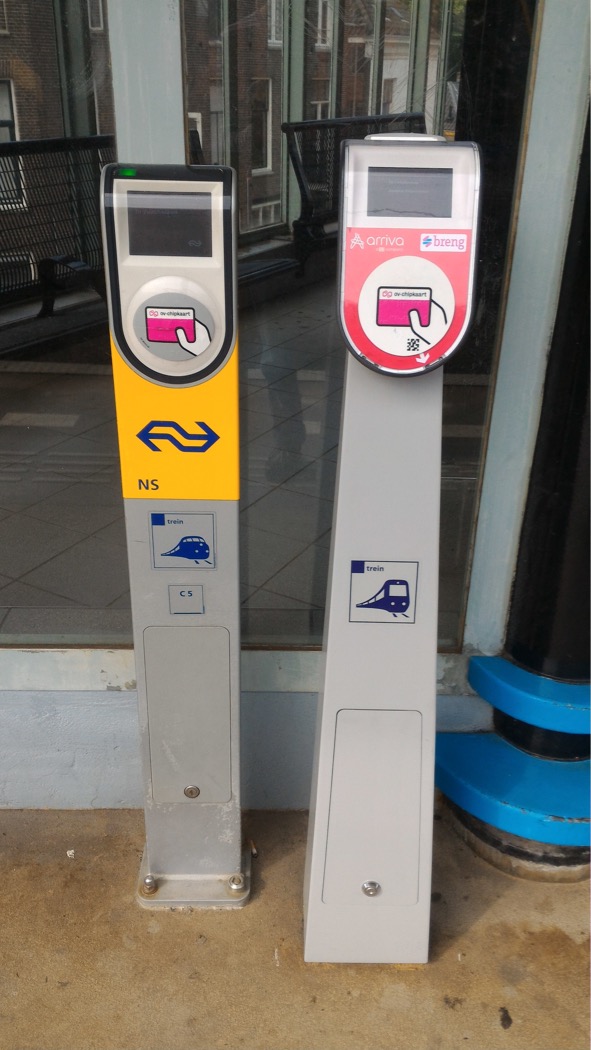
On the other hand, check-in gates have barriers which, if closed, restrict access to the platforms, and only open as one checks in or out with an OV-chipkaart. One side of the gate has a card reader for checking in, and the other side has a card reader for checking out. Sometimes the gates are not closed; you still need to check in or out at these open gates at the correct side, as if the gates were closed. (Don't mix them up!)
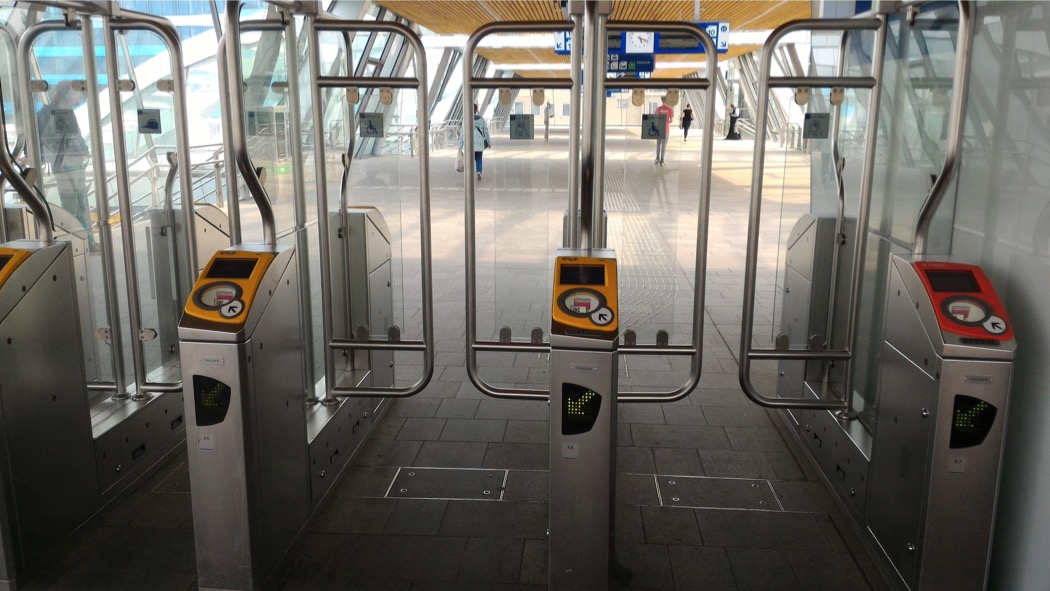
Whether stations have gates or not is not determined by the size of a station; some very small stations have gates, while some large stations do not have gates. This map of tariff units shows gated stations with a red symbol next to the name of a station.
Different train companies use different check-in portals. There are five systems of check-in portals: NS, Arriva, Blauwnet, Valleilijn, and R-net/Qbuzz. Most stations only have one system of check-in portals. Some have two, and only one station has three. There are more than five companies/brands running trains in the Netherlands. Use this algorithm to determine which system of check-in portals to use when you are using an OV-chipkaart:
- If the station has one system: use that system. (The R-net/NS line Alphen aan den Rijn – Gouda uses NS check-in portals; no need to check out and in again when changing between this line and the connecting NS lines);
- If the station has two systems, then one will be NS:
- If catching NS trains (including ICE Amsterdam – Frankfurt/Basel and IC Amsterdam – Berlin), or NMBS/SNCB (Belgian rail) trains, then use NS check-in portals
- Otherwise use the non-NS check-in portals (including German local trains run by VIAS or DB regio)
- At Zutphen station, use the respective check-in portal system: NS, Blauwnet, and Arriva
This information is displayed in the operators map and the local train maps above. If in doubt, the NS journey planner (website or app) tells you which system to check in and out at what point when displaying a suggested itinierary.

If you change trains within one system, you do not need to check out and in again when changing trains. (Except in some rare cases where different platforms are in separate paid areas.) If you change trains belonging to different systems, there are check-in poles of each system standing next to each other on the platform; you check out of one system (the system of the train that you have just stepped out of), and then in with the other system (the system of the train that you are changing to). Checking out and in again within 35 minutes at the same station is considered a transfer. With NS, a transfer within the NS system continues the non-peak or peak rate, depending on the time that the passenger first checked into the NS system.
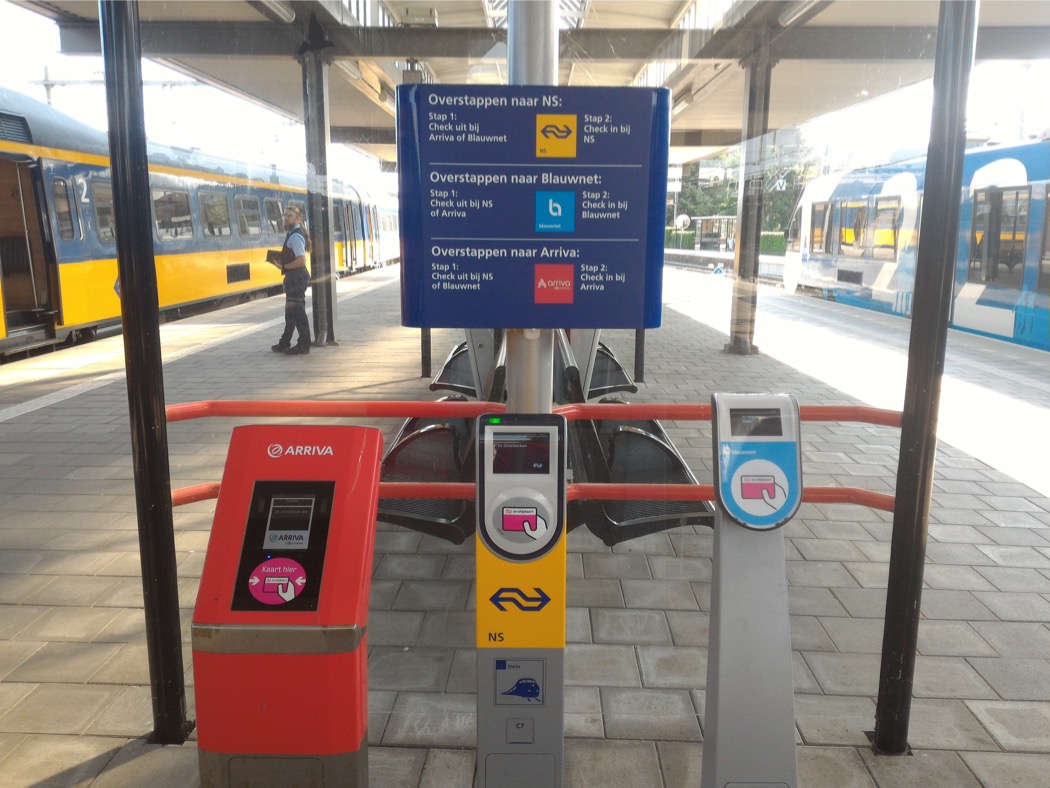
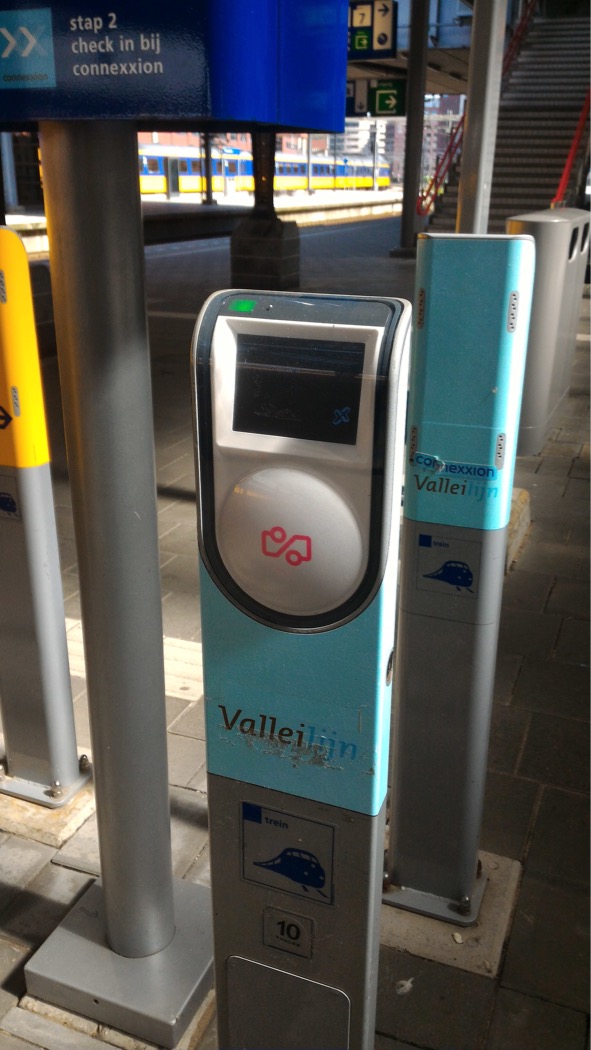
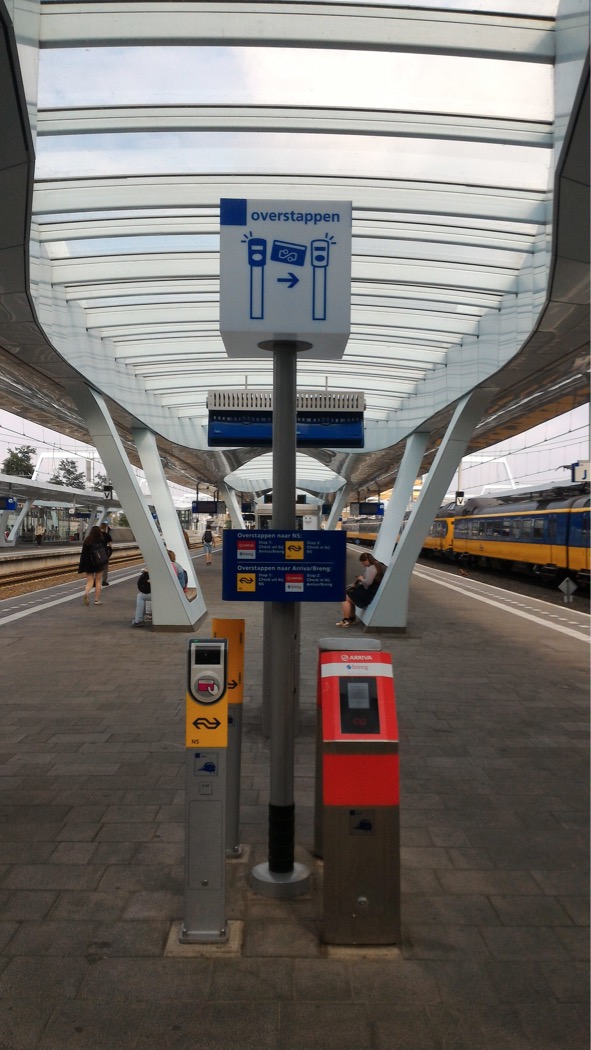
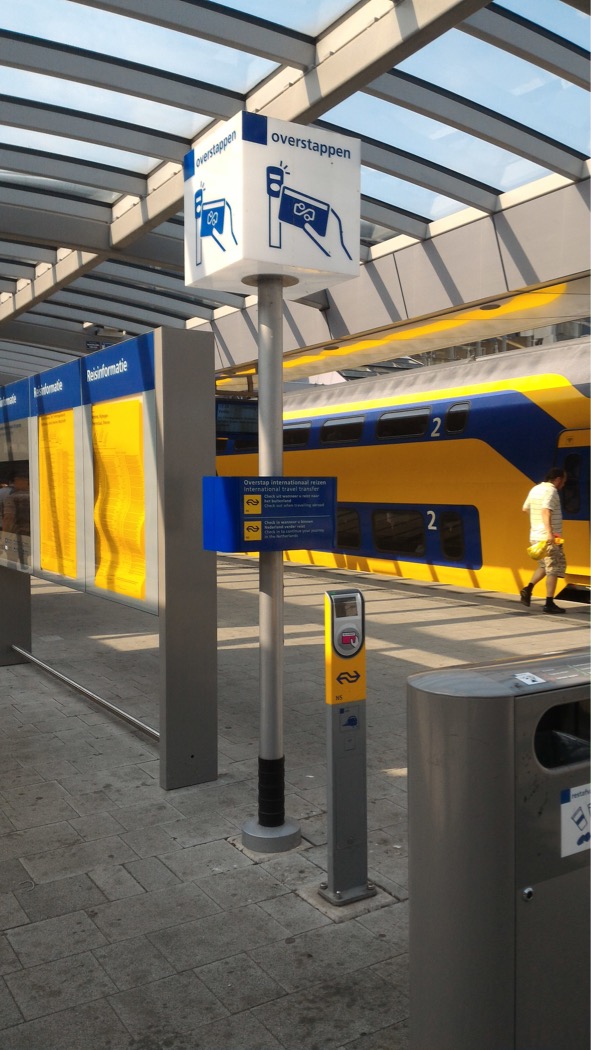
If you check out at one of the transfer poles on the platform, and then soon after check out at a gate at the same station, the gate will let you just pass through without charging extra.
If you check out at a gate (not pole) and if there is no prior check-in record (e.g. you forgot to check in, you arrive in a train from Germany or Belgium and you accidentally use your Dutch OV-chipkaart to leave a station instead of your German/Belgian ticket), you will be charged a check-in deposit, which can be as much as €20.
There are metros in Amsterdam and Rotterdam/The Hague areas. There are some stations where NS and metro trains share the same paid area, or even an island platform; you can find their respective check-in poles standing next to each other for transfering.
Nearly all metro stations have OV-chipkaart ticket gates. On the other hand, with buses/trams/ferries, their card readers are inside the vehicle; most usually you have to check IN and OUT of each individual bus/tram/ferries that you board (ask if in doubt). Currently there is one section left where metro and trams share platforms: near The Hague between Den Haag Laan van NOI and Leidschenveen, metro line E and trams 3 and 4 share all the stations in between. They stop at different sections of the platform: metros use raised platform, whereas trams use lowered platform. The card readers for metro are on the platforms, while the card readers for trams are inside the tram. You have to check out of one and check in with the other when changing between them, and don't get them mixed up.
Surcharges
(The terms 'surcharge' and 'supplement' are used here interchangeably.) There are two services that incur surcharges on top of the normal domestic tariff in the Netherlands. Not having purchased them before boarding these trains can lead to a hefty administrative cost, or fine:
- ICE supplement: travellers can travel on the ICE domestically in the Netherlands (Amsterdam Centraal – Utrecht Centraal – Arnhem Centraal) with a normal domestic ticket/OV-chipkaart, plus an ICE supplement. The ICE supplement is €2.7, and it can be purchased as an e-ticket, a disposable OV-chipkaart from a ticket machine (no ticket-issuing fee), or loaded into a durable OV-chipkaart. The ICE supplement is not applicable to passengers with an NS subscription, NS-business card, student subscription, or children travelling on Railrunner or Kids Vrij. The ICE supplement is also not applicable to the section of ICE service in the Netherlands included in an international ticket.
- Intercity direct (ICd) supplement: when travelling domestically in the Netherlands, on either the domestic or international ICd service, there is an ICd supplement on the high-speed rail line between Schiphol Airport and Rotterdam Centraal. The ICd supplement is €2.7, and it can be purchased online as an e-ticket, or from a ticket machine as a disposable OV-chipkaart (no ticket-issuing fee). For people with a durable OV-chipkaart, instead of the aforementioned methods, one can pay the ICd supplement by tapping the ICd supplement poles (red in colour) on the platforms at Amsterdam Centraal, Schiphol Airport, Rotterdam Centraal, and Breda. Tap the durable OV-chipkaart only once before you board the train. (Tapping this pole again within 30 minutes cancels the purchase. DO NOT tap the ICd supplement pole again after you get off the train.) The ICd supplement is lowered to €1.56 if it is paid by tapping an ICd supplement pole DURING OFF-PEAK period. The off-peak rate tapped at Amsterdam Centraal or Breda right before peak time is valid on ICd services while it is travelling between Rotterdam Centraal – Schiphol Airport during peak time. The ICd supplment is not applicable to children travelling on a Railrunner ticket or Kids Vrij subscription, and to passengers with an international rail ticket that is valid between Schiphol and Rotterdam.

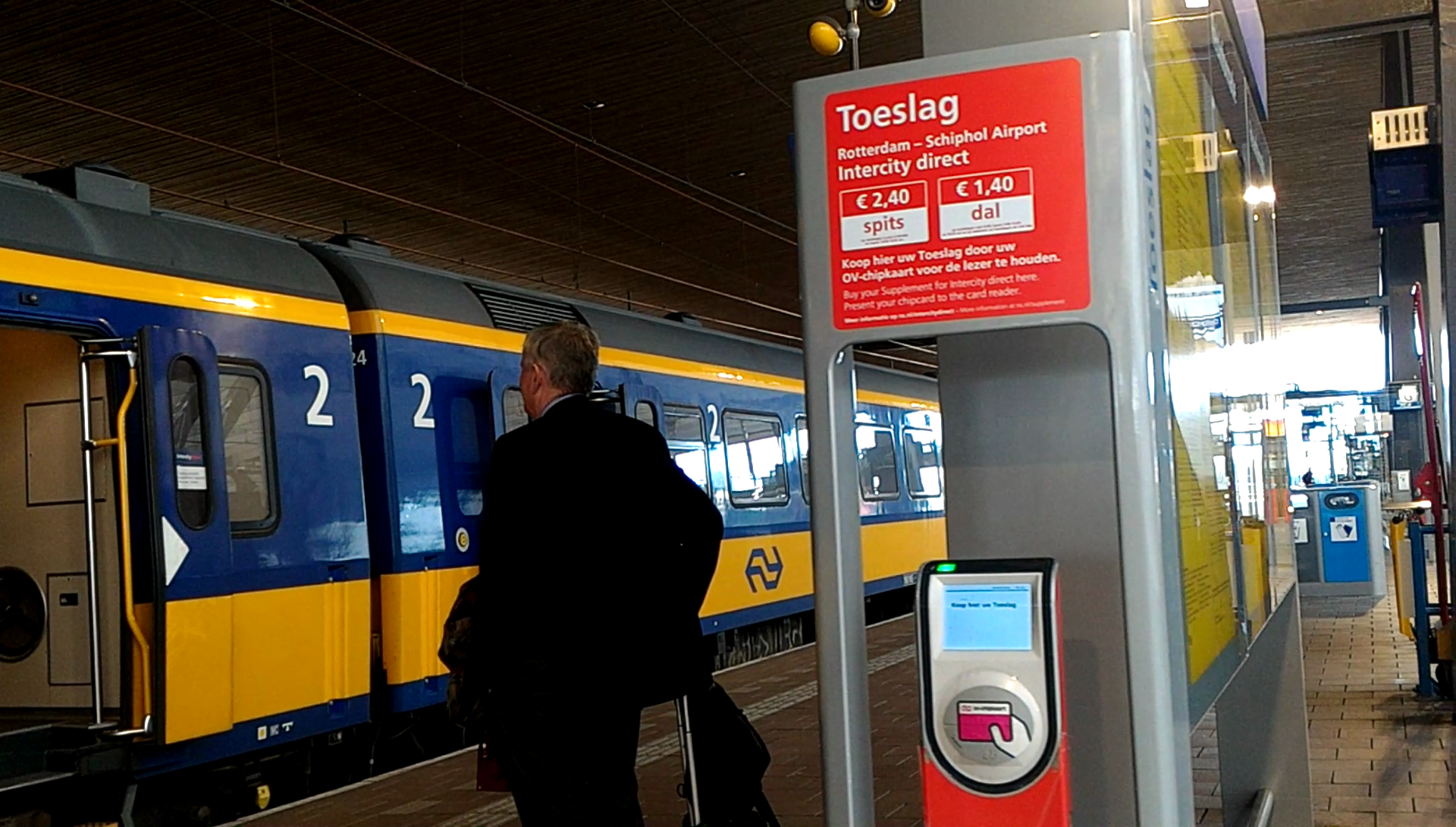
Children, students, and seniors
0 to 3 year-olds do not need to pay, and do not need to have a ticket. They do not have the right to occupy a seat.
Children 4 to 11 years can get a Railrunner ticket, which costs €2.5, for one day of unlimited train travel in the Netherlands. It can be purchased as an e-ticket from the NS website, as a disposable OV-chipkaart from a ticket machine (no ticket-issuing cost), or loaded into a durable OV-chipkaart (the child needs their own anonymous or personal OV-chipkaart). With a Railrunner ticket, a child 4 to 11 years old can travel: a) independently in second class(!); or b) in first class when accompanied by an adult 18 years or older with a valid ticket in first class; each such adult can accompany at most three children, each with their own Railrunner ticket.
Alternatively, children can get a Kids Vrij subscriptions, currently costing €0.01 a year. The only extra cost is €7.5 if they do not already have a personal OV-chipkaart. A child travelling on Kids Vrij has to be accompanied by a passenger 12 years or older with a valid ticket. Each such older passenger can accompany at most three children, each with their own Kids Vrij subscription. The child travels in the same class as the accompanying older passenger.
Railrunner and Kids Vrij are valid for all train travel in the Netherlands (except Thalys and Eurostar). If it is in an OV-chipkaart, check in and out as usual. Children on these do not have to pay the ICE supplement or the ICd supplement (see above). For international travel: a) in Germany, with DB, children under 6 do not need a ticket; older children under 15 years old can have their names added to their parent's or grandparent's ticket, and these children travel for free; otherwise tickets for 6-14 year-olds are half the adult price; b) in Belgium, 0–3 year olds do not need to pay. For 4–11 year olds, each passenger 12 years or older with a valid ticket can take along four such children along for free; otherwise, a child ticket is required; c) in Luxembourg, domestic public transport is free (except for first class train travel). For France, see this page.
There are no special single or return tickets for students or seniors. However, there are special subscriptions for students. Seniors get extra privilages with some of the usual subscriptions; see Keuzedagen.
Bicycles and pets
Folding bicycles that are fully folded up are treated as normal luggage, and can travel on trains for free at all times. For other bicycles, the NS bicycle ticket is valid for all Dutch railway companies. However, Arriva has better deals with some of their lines.
- NS: with a fietskaart dal 'off-peak bicycle ticket' (€7.5), bicycles are allowed onboard outside peak time (06:30–09:00, 16:00–18:30) during weekdays, the whole day during weekends and holidays, and the entirety of July and August. Bicycles are allowed on Intercity direct, but not on ICE. On the Amsterdam–Berlin InterCity and Amsterdam–Brussels InterCity, during rush hour and in July and August, the transportation of bicycles is reserved for passengers with an international bicycle ticket. Outside these periods, the transportation of bicycles is possible on these routes domestically without reservation.
- Breng: same as NS.
- Keolis: same as NS.
- Connexxion (Valleilijn): same as NS.
- MerwedeLingelijn R-net/Qbuzz (Geldermalsen – Dordrecht):free/gratis! Trains on this line can take maximally 12 normal bicycles.
- Arriva, roughtly from north to south:
- Groningen and Friesland (Arriva lines to/from Groningen or Leeuwarden): other than the normal NS bicycle day-ticket, there is a cheaper Arriva bicycle day-ticket Arriva Fiets Mee Dag (€4), valid only on Arriva trains in this region. The time of validity is also different: the Arriva bicycle day-ticket is valid from 09:00 on weekdays, and the whole day on weekends and holidays. The Arriva bicycle day-ticket can be purchased from the Arriva ticket machines in the region or online.
- Vechtdallijnen (Zwolle – Emmen, Almelo – Hardenberg): same as NS.
- Gelderland (Arriva lines to/from Zutphen or Arnhem Centraal): same as NS, except that: a) bicycles can be taken for free during the weekend and the whole of July and August (public holidays that fall on weekdays do not count); b) bicycles are banned on koningsdag (27 April) and bevrijdingsdag (05 May). See the pdf in that page.
- Limburg: there is a Dal Dagkaart Fiets Trein en Bus (€6.55), a day ticket valid on Arriva trains and most Arriva buses in Limburg (subject to space availability). Valid after 09:00 on weekdays, and the whole day on weekend and holidays.
See here for international train travel for bicycles, including domestic travelling on international services. When doing your own search on the internet about bicycle transportation, words to search for are fiets meenemen in Dutch, Fahrradmitnahme in German, and vélo à bord or voyager avec vélo etc. in French.
A smaller pet that fits in a small carry case or sits on your lap do not need a ticket. A larger pet needs a dog ticket (€3.3), valid for NS and Arriva. Clearly identifiable guide dogs and trainee guide dogs (e.g. ones showing logos of guide dog organisations) do not need a dog ticket.
See here for pets on international trains.
Breaking, detours, and fares
Except for non-flexible high-speed-rail tickets, and German Sparpreis Europa tickets for the ICE/IC/EC sections, breaking of journey is allowed in the Netherlands. Feel free stop at a station mid way, and continue your journey later in the day. In the Netherlands, a ticket is valid for train services (on the designated route) of which the scheduled departure time, at the station where you board the train, is earlier than 04:00 the following day. Durable OV-chipkaarts need to be checked out within six hours of the last check in, and checking in again within 35 minutes of the last check-out is considered a transfer (a continuation of the same journey; a flagfall is not charged again).
NS and the Leeuwarden/Groningen lines of Arriva charge fares based on 'tariff units' (map, rates). Each unit is roughly 1 km in distance, but some sections charge more tariff units than actual distance. 0 to 8 units cost the same, and the price increases with basically each unit unitl 200 units. Journeys within the Netherlands that are longer than 200 units are charged 200 units. Other companies/lines have tariffs based on the actual distance in km, plus a flagfall. See the tables of second-class full-fare tariffs here; if the basistarief 'flagfall' is not listed, the full-fare flagfall is €0.99 in 2021. If a journey involves changes between companies, only the flagfall of the first company applies, so the price of an outbound journey can be different from that of the return journey along the same route if there is a change of company.
If a ticket only states a 'from' station and a 'to' station, you are meant to take the shortest possible route between the 'from' station and the 'to' station; see what the NS journey planner suggests. If NS thinks that there are two reasonable routes for your journey, the ticket machine/website/app will show you the price difference, and ask you which option you want to take. A third option is also offered, which is paying the higher price, and you can take either route.
Near two opposite ends of a railway loop, the tariff units are often configured so that it cost the same to travel through either side of the loop, despite slight difference in the actual distance. For instance, an NS ticket from Amsterdam Centraal to Rotterdam Centraal allows the traveller to travel on either the faster InterCity via Den Haag HS (the western route), or the slower Sprinter via Breukelen (the eastern route), despite the actual travel distance being different. The tariff units are configured so that it is 86 units on both routes. Another possible route is Amsterdam Centraal to Schiphol Airport, and then InterCity from Schiphol Airport to Rotterdam Centraal, which is also 86 units. Intercity direct all the way from Amsterdam Centraal to Rotterdam Centraal travels on a much shorter route, but the base fare is also 86 units. (An ICd supplement is charged on top of that.) Check route suggestions and price information given by the NS journey planner.
When there are track works or accidents, which affect the journey stated in your ticket, you can use your ticket as usual, and take the railway detour recommended by the railway companies. If you're using an OV-chipkaart, you are meant to check in and out as usual along your detour if a change of system is involved. Train conductors have hand-held devices which have real time information on track works and accidents. (However, sometimes they tell you to change to metro around Amsterdam or Rotterdam, and not provide replacement buses; in this case, you'll have to buy a separate metro ticket, or check-out-and-in with a durable OV-chipkaart. If you have a Dutch bank account (perhaps bank accounts from other Euro/IBAN countries work as well?), maybe you want to contact NS customer service and ask them for a refund for the extra cost incurred. This tweet from NS says that you can ask them for a refund in such cases.)
Accessibility issues
This is the NS disability page. It has information for passengers with various types of accessibility requirements.
For passengers with, e.g., visual impairment, mobility requirements, NS has a travel assistance service. Many local trains are wheelchair-accessible. On the other hand, most faster trains are unfortunately not. Travel assistance is available at many stations; railway staff can set up ramps for pre-booked passengers. You need to make a request at least one hour beforehand (it is said that with online bookings, in some cases they can try to handle requests within one hour), giving them the details of your intended travel (date, time of departure, departure and arrival stations). Other than the usual telephone number of +31 30 2357822, you can make a request through the NS app (android, iOS), or through Mijn NS. This map shows the stations with travel assistance service (February 2020). Travel assistance is available from the first train till the last train, excluding Nachtnet trains.

The NS app (android, iOS) can tell you whether the doors open on the left or right hand side, both visually and audially. See here for details.
The NS Perronwijzer app (android, iOS) is designed to work together with a screen reader (i.e. text to speech). It gives the train service information at each platform: train departure time, destination, arrival time at each station, and departure time of the following train at the same platform.
haltescan.nl is a website that gives accessibility information on all train stations, bus stops, etc.
Here are some Dutch words/phrases that may be useful for online search or real-life interactions:
- rolstoel(en) 'wheelchair(s)'
- toegankelijk 'accessible'
- toegankelijkheid 'accessibility'
- toegankelijkheden 'accessibilities'
- gebruik(en) 'use/s'
- gebruiker 'user'
- mindervalide(n) 'less-abled person/people'
- beperking(en) 'limitation(s)/impairment(s)'
- beperkt 'limited/impaired'
- handicap(s) 'disability/ies'
- gehandicapt(en) 'handicapped/ handicapped person/people'
- chauffeur, rolstoelplank alstublieft '(bus) driver, wheelchair ramp please' (sometimes they forget)
- dank u 'thank you'
- doof/slechthorend 'deaf/hard-of-hearing'
- auditief beperkt/gehandicapt 'audially impaired/handicapped'
- gebarentaal 'sign language'
- blind/slechtziend 'blind/hard-of-sight'
- visuele beperkt/gehandicapt 'visually impaired/handicapped'
- geleidenhond 'guide dog'
- blindenstok 'guide stick'
- braille
Toilets
All InterCity trains have toilets. Since late 2021, all Sprinters have accessible toilets. The situations with trains not run by NS varies.
Other public transport operators
Most forms of public transport in the Netherlands are part of a public transport concession. Some concessions include only a few lines, while others cover a large area, including multiple forms of public transport. There are around 50 public transport concessions in the Netherlands. Most of these are publically contested; every year, some concessions expire and some are awarded to a different company. Maps of the main non-train concessions, e.g. the following map of the 32 main regional concessions, can be found in this page from the OV in Nederland Wiki.
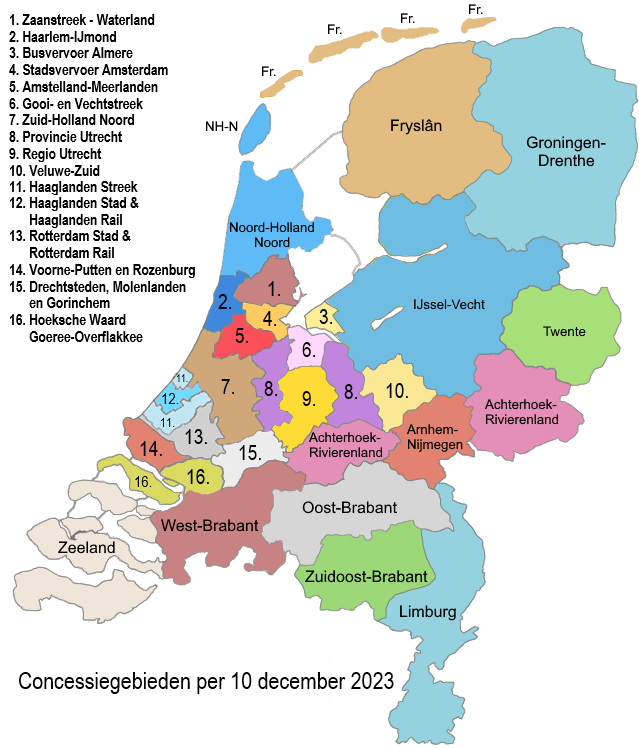
OV-chipkaart can be used for all domestic trips on trains and metros. The card readers are on the platforms or at another part of the station. Tickets cannot be purchased on board (unless it is a ticket that is sold together with a fine).
OV-chipkaart can also be used on all light rail and trams, the vast majority of buses/trolleybuses, and some ferries. With these, the card readers are located inside the vehicles themselves, and passengers most usually have to check IN and OUT inside each vehicle. On board these vehicles, cash payment has mostly been fased out. Passengers have to either: a) pay with a durable OV-chipkaart; b) show a valid e-ticket; c) show a valid ticket purchased at a ticket machine / ticket counter / authorised shop; or d) pay with electronic means on board a vehicle.
Train deals with Germany, Austria and Switzerland
Some Dutch rail services extend into Germany, and several German rail services extend into the Netherlands. For domestic trips within the Netherlands on these trains, Dutch ticketing applies: OV-chipkaarts can be used, and the NS-issued normal tickets are valid. The Dutch OV-chipkaart can be used between the Netherlands and these stations right across the border in Germany (from north to south): Weener / Leer; Gronau; Herzoganrath / Aachen West / Aachen Hbf. (Going international on these lines, using Dutch OV-chipkaart or an Arriva e-ticket gives a better price than booking through NS International or DB.) Otherwise German ticketing applies.
The most important distinction amongst the German passenger rail services is Nahverkehr 'near traffic' (i.e. local trains) versus Fernverkehr 'long-distance traffic'. The commonest types of local trains are S-Bahn (S), Regionalbahn (RB), Regional-Express (RE), and Interregio-Express (IRE). The commonest types of long distance trains are EuroCity (EC), Intercity (IC), and Intercity-Express (ICE). Most usually, long-distance trains have dynamic pricing, while local trains have fixed pricing. In this respect, Germany is similar to France, but different from Benelux, where InterCity's have the same fixed pricing as local trains. I'll talk about Nahverkehr tickets first, and then Fernverkehr tickets, and then the German ticket machines in the Netherlands.
See what DB says about carriage of bicycles in general.
Nahverkehr tickets
As for German local train services, there are many tickets that are valid for local trains and other public transport throughout a state, or more locally throughout a Verkehrsverbund 'transport authority'. There are two German states that border the Netherlands: Niedersachsen 'Lower Saxony' in the north, and Nordrhein-Westfalen 'North Rhine-Westphalia' (NRW) to the south. At a more-local level, public transport in most areas in Germany are organised by transport authorities. The following is a map of the German Verkehrsverbünde from German Wikipedia. The Dutch–German border lies from the VEJ area (Ems-Jade) in the northwest down to the middle of the AVV area (Aachen). In the areas in Lower Saxony that border the Netherlands, the transport authorities only coordinate bus operations, but not train operations (grey areas in the map: VEJ, bvE, VGB). On the other hand, in North Rhein-Westphalia, the four transport authorities (WT, VRR, AVV, VRS) have coordinated fare structure for both local trains and all other forms of public transport.

Lower Saxony
An interactive map of the local train lines in Niedersachsen 'Lower Saxony' is here.
In Lower Saxony, there is the Niedersachsentarif, which is a unified fare structure for the local trains in the states of Lower Saxony, Breman, Hamburg (fare zones AB), and some bordering regions, including the Eurobahn RB 61 to Oldenzaal and Hengelo in the Netherlands. Also included is the IC/EC line between Bremen and [Norddeich Mole or Emden Außenhafen]. Included in the scheme are occational tickets (Einzelkarten, e.g. single, return) and long-term tickets (Zeitkarten; i.e. weekly, monthly, yearly tickets). With occational tickets, connecting buses/trams/U-bahn are included at the origin and destination train stations in many regions. With the long-term tickets, you have to purchase a separate add on for the connecting buses/trams/U-bahn. Note very carefully the range of connecting public transport services that participate in the occational ticket scheme and/or the long-term ticket scheme. For instance, Hamburg express bus (Schnellbus) is not included in the occational tickets, while connecting subscription is not available in the entire HVV (Hamburg public transport) region with Lower Saxony long-term tickets. It is very complex; check the Niedersachsentarif page.
Simpler are their state-wide one-day tickets: Niedersachsen-Ticket, and the Niedersachsen-Ticket plus Groningen. The Niedersachsen-Ticket costs €23/28/33/38/43 for 1/2/3/4/5 people, and gives unlimited travel on local trains and all other regular public transport in Lower Saxony, Breman, Hamburg (fare zones AB) for one day. In the validity map of Niedersachsen-Ticket: a) the red lines are the rail lines where the Niedersachensen-Ticket is valid (only for local trains, so not for ICE/IC/EC); b) the doubled up black line between Norddeich Mole/Emden Außenhafen and Bremen is the trajectory where the Niedersachsen-Ticket and other local fares are valid on the EC or IC trains; c) the grey areas is the entirety of Lower Saxony, Bremen, and Hamburg where the Niedersachsen-Ticket is also valid on local buses/trams/U-bahn (this is majorly improved from the preceding two years).
With buses, on the border with the Netherlands, (theoratically) the Niedersachsen-Ticket is valid on all buses that cross into the Netherlands. Buses that cross into the Netherlands are: a) in VEJ area, bus 620 Leer – Weener/Bunde extends to Bad Nieuweschans in the Netherlands infrequently; b) in the BVE area, bus 922 Meppen – Emmen (currently suspended); c) in VGB area, bus 38 Nordhorn – Denekamp.
The Niedersachsen-Ticket plus Groningen costs €29/35.5/42/48.5/55 for 1/2/3/4/5 perople. This has the same validity as the Niedersachsen-Ticket, plus an extension on the Dutch Arriva line between Weener and Groningen (including the Arriva replacement buses).
Eurobahn provides this map (the 'tariff outline map' at the bottom of this page) explaining the validity of the Dutch, Lower Saxon, and North Rhein-Westphalian tariffs on their lines in this region. (This information for RB 61 is also outlined in English in the local maps above.)
North Rhine-Westphalia (NRW)
An interactive map of the local train lines in Nordrhein-Westfalen 'North Rhine-Westphalia' (NRW) is here.
In NRW, there are four local transport authorities: WT (Westphalia), VRR (Rhine-Ruhr), AVV (Aachen), and VRS (Rhine-Sieg), each having unified ticketing for all local trains and U-Bahn/trams/buses/hanging rail etc. in their areas. All the German local trains running directly between NRW and the Netherlands (Enschede, Arnhem Centraal, Venlo) are covered by their tickets. The Dutch local train line to Aachen Hbf is covered by German tariff up till Heerlen in the Netherlands. Many German cross-border buses are also covered. (Check carefully with each bus route whether Dutch and/or German ticketing applies. The only German bus line in NRW that accepts Dutch OV-chipkaart is SB58 Nijmegen – Kleve – Emmerich, as far as I know.) Other than the tickets of the transport authorities, there are also the NRW-Tarif tickets, which covers the local trains and other local public transport in the entire state of NRW. For their PauschalpreisTickets 'flat rate tickets' (time-based tickets that are not trajactory-specific), they also cover the local trains and buses between NRW and the Netherlands (same coverage as the cross-border trains/buses with WT/VRR/AVV). The best known of these flat-rate NRW tickets are the SchönerTagTicket NRW Single (€30.3 for 1 person for one day), and the SchönerTagTicket NRW 5 Personen (€45.2 for 5 people for one day). The validity map of the NRW-Tarif for local trains is at the bottom of this brochure: NRW-Tarif is valid on the coloured lines (including grey) in NRW and their extensions into other states and the Netherlands, but not the black lines. The solid lines are rail lines where the Tickets zum Verbindungspreis 'trajectory price tickets' are valid (e.g. single tickets across the four transport authorities). The solid lines plus the dotted lines are where the Tickets zum Pauschalpreis 'flat rate tickets' are valid, including the SchönerTagTicket NRW. To the Netherlands there is RB 51/64 to Enschede, RE 19 to Arnhem Centraal, RE 13 to Venlo, and RE 18 up till Heerlen. (Extra lines in the Netherlands that are listed as being valid in the terms and conditions of the SchönerTagTicket NRW are Heerlen Woonboulevard – Heerlen and Heerlen – Kerkrade Centrum.) Some notable black lines (i.e. where NRW-Tarif is NOT valid) are: a) RB 61 between Hengelo and Rheine (which is mostly in Lower Saxony); b) RE 18 in the Netherlands west of Heerlen; and c) RE 29 the Belgian local train line to/from Aachen Hbf.
With buses, the following buses that cross into the Netherlands are explicitly mentioned in the documents of the NRW transport authorities as being included in the NRW-Tarif (December 2018):
- WT: T88 Enschede – Alstätte, R71 Winterswijk – Vreden, T55 Winterswijk – Oeding, T10 Winterswijk – Barlo, C11 Aalten – Bocholt, C7 Dinxperlo – Bocholt
- VRR: 91 's-Heerenberg – Emmerich, 60 Millingen – Kleve, SB 58 Nijmegen – Kleve – Emmerich, 29 Venlo – Vluyn (the predecessor 929 Venlo – Duisburg is mentioned in the VRR terms and conditions)
- AVV: SB 3 Sittard – Geilenkirchen, 34 Kerkrade – Aachen, 25 Vaals – Stolberg, 33 Vaals – Aachen
Nationwide local transport tickets
See the Germany section in the home page for the local transport tickets that covers the whole Germany.
The Euregio ticket
The Euregio ticket costs €19, and it gives unlimited travel for one day on buses and many train lines in southern Dutch Limburg province (Roermond and further south), Belgian Limburg and Liège provinces (including the Deutschsprachige Gemeinschaft 'German-speaking community'), and in Germany the AVV region, and Kreis Euskirchen (part of the VRS region to the south of the AVV region). During the weekend and holidays (the rule says any Belgian/Dutch/German holidays), it is valid for two adults and three children under 12 years old. Best if you bring the brochure along, as some bus drivers and train conductors might not know what the Euregio ticket is when presented with one. Check very carefully what train and bus lines are and are not covered in each province/region. In the map of the brochure: a) with trains, the blue dotted lines are railway lines where the Euregio ticket is valid, while the grey dotted lines are lines where it is NOT valid. In Germany, it is only valid on local trains (S-Bahn, RB, and RE). It is also not valid on Thalys, ICE, and EuroNight; b) with buses, the Euregio ticket is valid on all buses in these regions (but check the range of public transport operators listed, lest you board a bus that comes in from another area). The red lines in the map are just some example bus lines.
Fernverkehr tickets
As for German long-distance services in the Netherlands, there is the Amsterdam – Frankfurt (/Basel) ICE service, and the Amsterdam – Berlin IC service. International travel on these services follows German-type long-distance ticketing, which has dynamic pricing. You can book these either through NS International or DB.
For international tickets that involve at least one section of ICE/IC/EC train travel in Germany, Flexpreis (full fare, flexible) and Sparpreis Europa / Super Sparpreis Europa (saver fare, less flexible / not flexible) are offerred. A (Super) Sparpreis ticket restricts you to particular ICE/IC/EC train services as stated on the ticket. The (Super) Sparpreis fluctuates, and it can run out. Free extensions in the Netherlands on non-high-speed trains connecting with the ICE or IC Berlin service is given, up to a certain distance. For instance, if you travel from Berlin to Zeeland (e.g. Vlissingen, Middelburg), the journey planner would typically route you to Deventer or Amsterdam before changing to domestic Dutch trains. Check what the price is all the way up to Vlissingen, versus the price for just Deventer or Amsterdam.Nightjet to/from Switzerland, Austria and Germany have their own ticketing (dynamic pricing); see above. When booking a Nighjet journey plus a connecting (non-high-speed) train journey entirely within the Netherlands, the connecting journey is maximally €9 (second class) or €15 (first class) one-way. The connecting fare is called "Connect Eurostar / Thalys / Nightjet - 2e klas" or "Connect Eurostar / Thalys / Nightjet - 1e klas".
German ticket machines in the Netherlands
For German local trains, German ticket machines give better price than the Dutch ticket machines. The following are the distributions of the German ticket machines in the Netherlands near the border, from north to south (plus some other related comments):
- Weener frontier, RB 57 Groningen – Leer: Dutch ticket machines and OV-chipkaart portals extend into Germany, to the stations of Weener and Leer (Ostfriesland). There is(?) a Deutsche Bahn counter within the Arriva service point at Groningen station, where one can buy Nierdersachsen-Ticket plus Groningen, and DB tickets. (Do they charge a ticket-issuing fee?)
- Bad Bentheim frontier, IC Amsterdam Centraal – Berlin Ostbahnhof, and RB 61 Hengelo – Bielefeld: there are NO German ticket machines at Oldenzaal, Hengelo, and the stations along the way to Amsterdam. For the IC service to Germany, you can purchase tickets from a Dutch ticket machine or ticket counter (no discount), at the NS International ticket office at Amsterdam Centraal, or the websites/apps of DB or NS International. For RB 61 to Germany, there are ticket machines inside the Eurobahn RB 61 trains. Eurobahn/Keolis Deutschland also says that their tickets can be purchased at the NS ticket office at Hengelo.
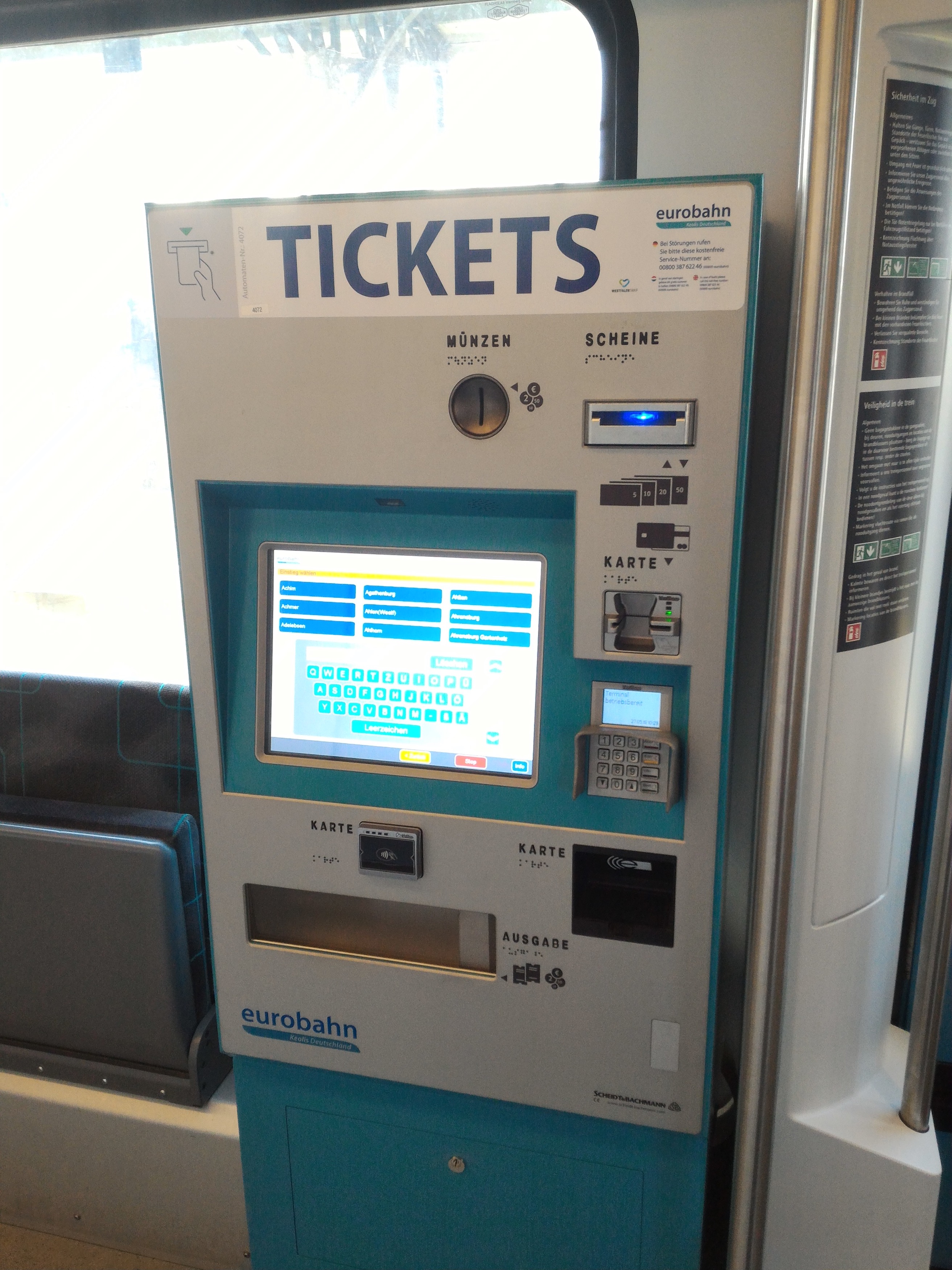
The ticket machine inside an Eurobahn train; it says Einstieg wählen 'select entry point', i.e. you have to input the departure station of your ticket first, and only after that you input the destination. (Note that Germany uses the QWERTZ keyboard layout.) - Gronau (Westfalen) frontier, RB 51 Enschede – Dortmund Hbf and RB 64 Enschede – Münster Hbf: there is a DB ticket machine in at least Enschede, which can handle local tickets of WestfalenTarif (WT), the state-wide NRW-Tarif, and also long-distance travel in Germany, selling both full-fare and saver-fare tickets (if available). There are also ticket machines inside the trains of RB 51 and RB 64 (information in 2018). At Enschede station, the German train platform (platform 4b) and the DB ticket machine are outside the Dutch paid area; people with a DB-issued ticket for further journeys in the Netherlands can ask station staff for a 'KeyCard' with a barcode to open the Dutch station gates.
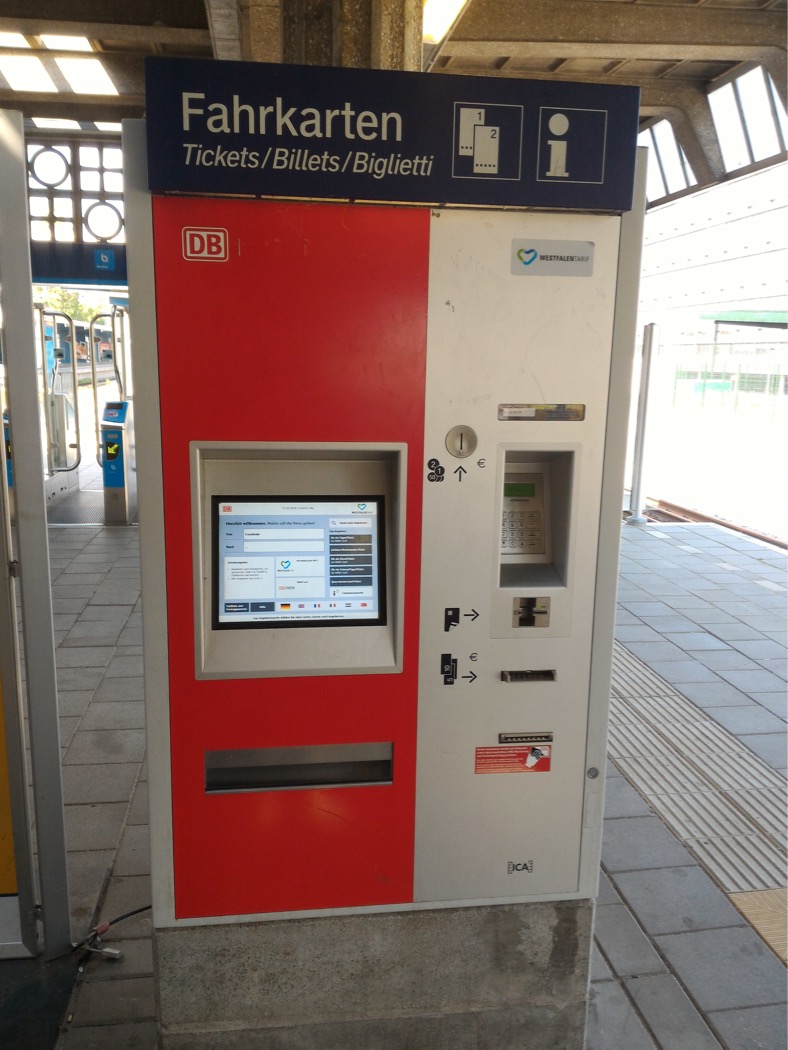
The Deutsche Bahn ticket machine at Enschede 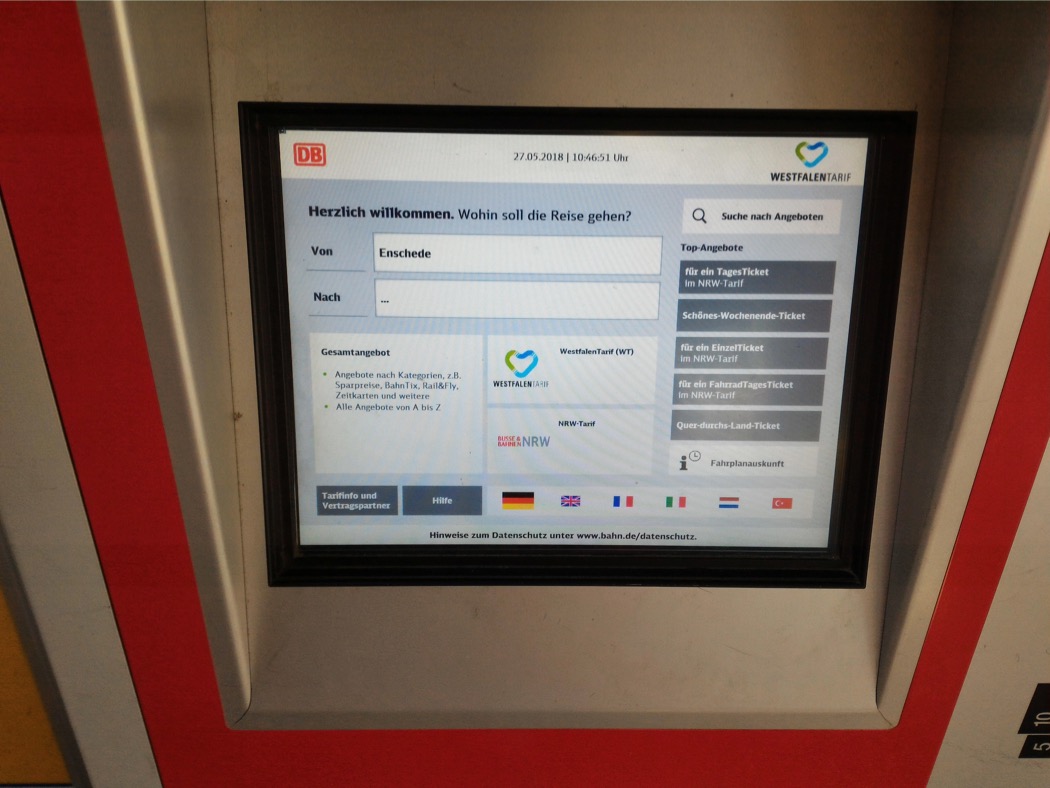
The initial screen; you can get tickets of WestfalenTarif, NRW-Tarif, and many other DB tickets 
Sign in German explaining the need to get a KeyCard to open the gates - Emmerich frontier, ICE Amsterdam Centraal – Frankfurt Hbf/Basel SBB, and RE 19 Arnhem Centraal – Düsseldorf Hbf: for the ICE service to Germany, you can purchase tickets from a Dutch ticket machine (no discount), at the NS International ticket ofices at Amsterdam C / Utrecht C / Arnhem C, or the websites/apps of DB or NS International. (The new operator VIAS has not yet installed ticket machines at Arnhem Centraal and Zevenaar.)
For RE 19 to Germany, there are Abellio ticket machines at Arnhem Centraal (one at the main station hall, one at the back entrance) and Zevenaar. However, these Abellio ticket machines can only handle local tickets of VRR-Tarif, and the state-wide NRW-Tarif; the long-distance or nation-wide German train tickets are not available. For passengers travelling from Germany to Arnhem Centraal, after the train departs Zevenaar, Abellio train staff gives out a 'KeyCard' with a bardcode that opens the gates at Arnhem Centraal, for passengers who need one. (VRR contactless cards can also open the gates at Arnhem Centraal. Do not use your Dutch OV-chipkaart to exit the gates at Arnhem C or elsewhere unless it has been checked-in elsewhere in the Netherlands! Otherwise you'll be charged the check-in deposit!) - Venlo frontier, RE 13 Venlo – Hamm (Westf): there are DB ticket machines inside Venlo station. Exceptionally, there are NO ticket machines inside the Eurobahn RE 13 trains.

DB ticket machines inside Venlo station hall (past the check-in poles) 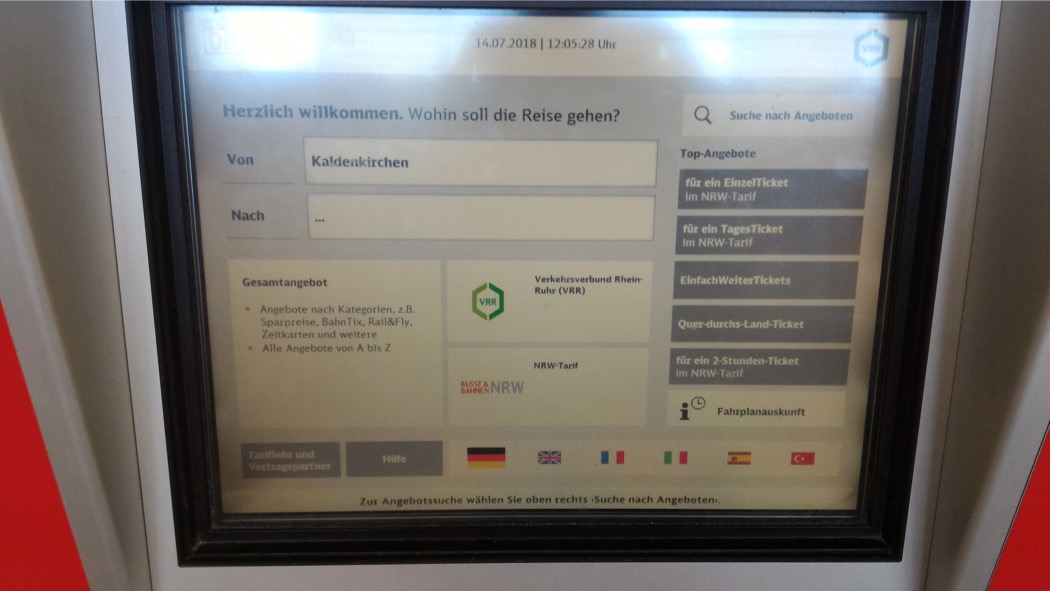
It sells the usual range of DB tickets, as well as the local VRR and NRW tickets. You might want to change the starting point of the ticket; the machine assumes that you are already in Germany! 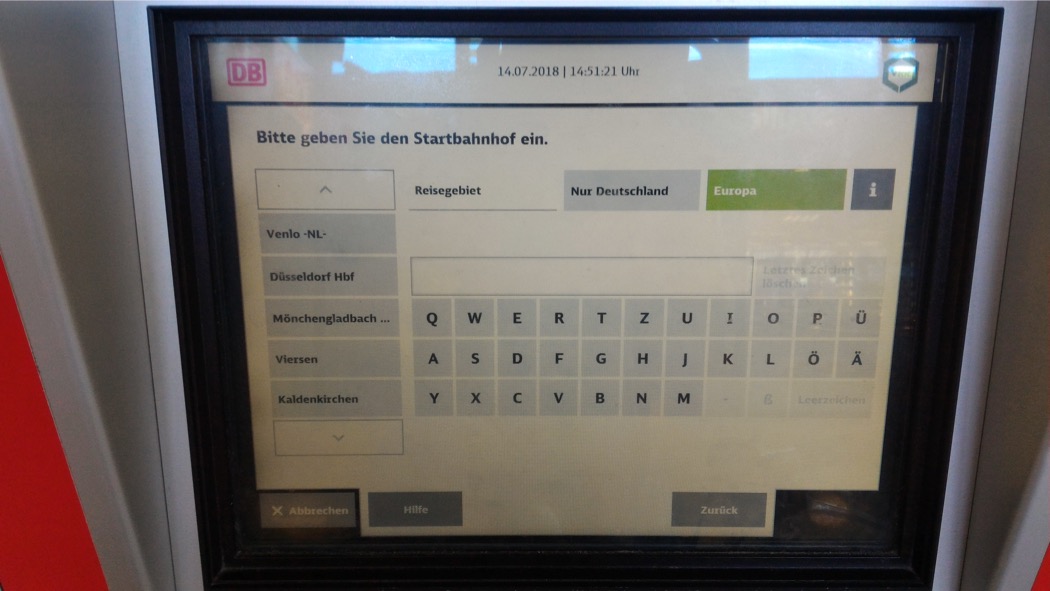
If you want to change the starting station from Kaldenkirchen, after pressing the starting station, you need to press Europa before Venlo appears - Herzogenrath frontier, RE 18 Maastricht – Heerlen – Aachen Hbf. DB ticket machines are no longer found in Heerlen station. RE 18 Maastricht – Heerlen – Aachen Hbf is run by Dutch Arriva.
Train deals with Belgium and Luxembourg
Also read further in the Belgium and Luxembourg pages. Between the Netherlands and Luxembourg, going through Belgium is usually faster and cheaper. However, it is also worth looking into going through Germany with a Sparpreis Europa ticket (see above), especially if the Belgian discounts do not apply in your situation, and/or you're going to/from places in the Netherlands near the German border.
Non-high-speed rail
There is the Early Bird deal, which gives a fixed-rate discount for non-high-speed train travel (including Intercity direct) between the Netherlands and Belgium, and between the Netherlands and Luxembourg via Belgium. This deal has to be booked seven or more days ahead of the departure date. For journeys on Monday to Thursday, the discount is 40% on average; for journeys on Friday to Sunday, the discount is 20% on average. There is no need to book too early ahead: the discounted rate remains the same seven or more days ahead. The full-flex rate remains the same throughout. It is best to book this deal online: the NS ticket machines and the normal ticket counters do not sell discounted tickets, and the NS International ticket offices and telephone booking charge a hefty booking fee for tickets that the ticket machines cannot handle.
For just between Roosendaal and Belgium, or just between Maastricht and Belgium, NMBS/SNCB offers their better fixed-rate fare. In general, if you have to go through Roosendaal or Maastricht, see whether travelling domestically to Roosendaal/Maastricht, and then getting a Belgian cross-border ticket is a better deal.
For the Euregio ticket, which is valid in the NL/DE/BE tripoint region, see above.
High-speed rail
Eurostar and Thalys have their own ticketing (dynamic pricing); see above. When booking a trip that involves Eurostar/Thalys and a connecting non-high-speed journey within the Netherlands in one ticket, the connecting trip is maximally €9 (at least when booking through official channels, e.g. NS International).
Belgian ticket machines in the Netherlands
For Belgian local trains, Belgian ticket machines give better price than Dutch ticket machines. The range of tickets offered by the Belgian ticket machines in the Netherlands (and Germany) is somewhat restricted, in comparison with the Belgian ticket machines in Belgium. For instance, the NMBS/SNCB Standard Multi (Rail Pass) is not valid in the Netherlands, and it is apparently not sold by the Belgian ticket machines in the Netherlands (and definitely not by NS). The following are the distributions of Belgian ticket machines in the Netherlands near the railway frontier points, from east to west (plus some other related comments):
- Visé frontier: there are Belgian ticket machines at Maastricht and Maastricht Randwyck, but apparently not at Eijsden (which is only served by Belgian trains! But for ticket from Eijsden to Belgium, you can buy a ticket from the train conductor without extra charge). For journeys within the Netherlands, Dutch ticketing applies. For journeys just between Maastricht / Maastricht Randwyck / Eijsden and Belgium through the Visé frontier, Belgian ticketing for Maastricht applies.
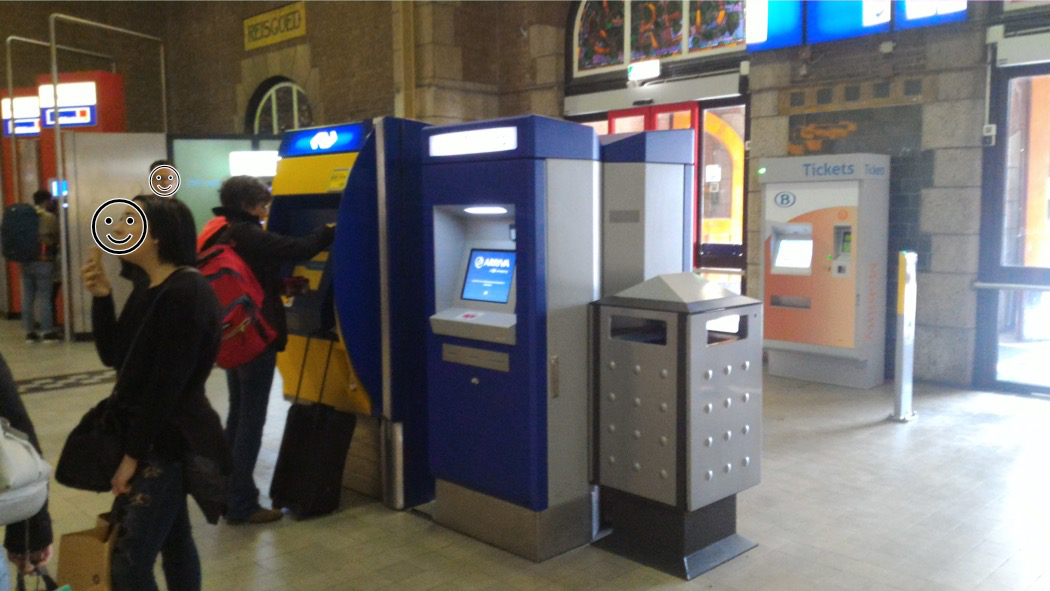
Some ticket machines at Maastricht station; from left to right, NS, Arriva, and in the background, NMBS/SNCB (old style) - Hazeldonk frontier: there are NO Belgian ticket machines at Breda or further north on the Intercity direct/InterCity routes to Amsterdam C or The Hague HS. Purchase a ticket from a Dutch ticket machine or ticket counter (no discount), at an NS International ticket office at Amsterdam C, Schiphol A, Den Haag C (not Den Haag HS where the train actually runs to/from!), Rotterdam C, or Breda. Alternatively, get an e-ticket (preferably at least seven days before the departure) through the NS international or NMBS/SNCB International websties/apps.
- Roosendaal frontier: there are Belgian ticket machines at Roosendaal. For journeys just between Roosendaal and Belgium through the Roosendaal frontier, Belgian ticketing for Roosendaal applies.

A NMBS/SNCB ticket machine (old style) near the NS ticket office at Roosendaal
The usual Belgian tickets for Dutch stations with gates (e.g. Roosendaal, Breda, but not Maastricht) have a barcode that can open Dutch station gates. Remember to use the ticket from Belgium, and not a Dutch OV-chipkaart, to exit a Dutch station gate! (If there is only exit record, but not entry record in the Dutch OV-chipkaart, you will be charged the entry deposit as you exit, which can be as high as €20!)
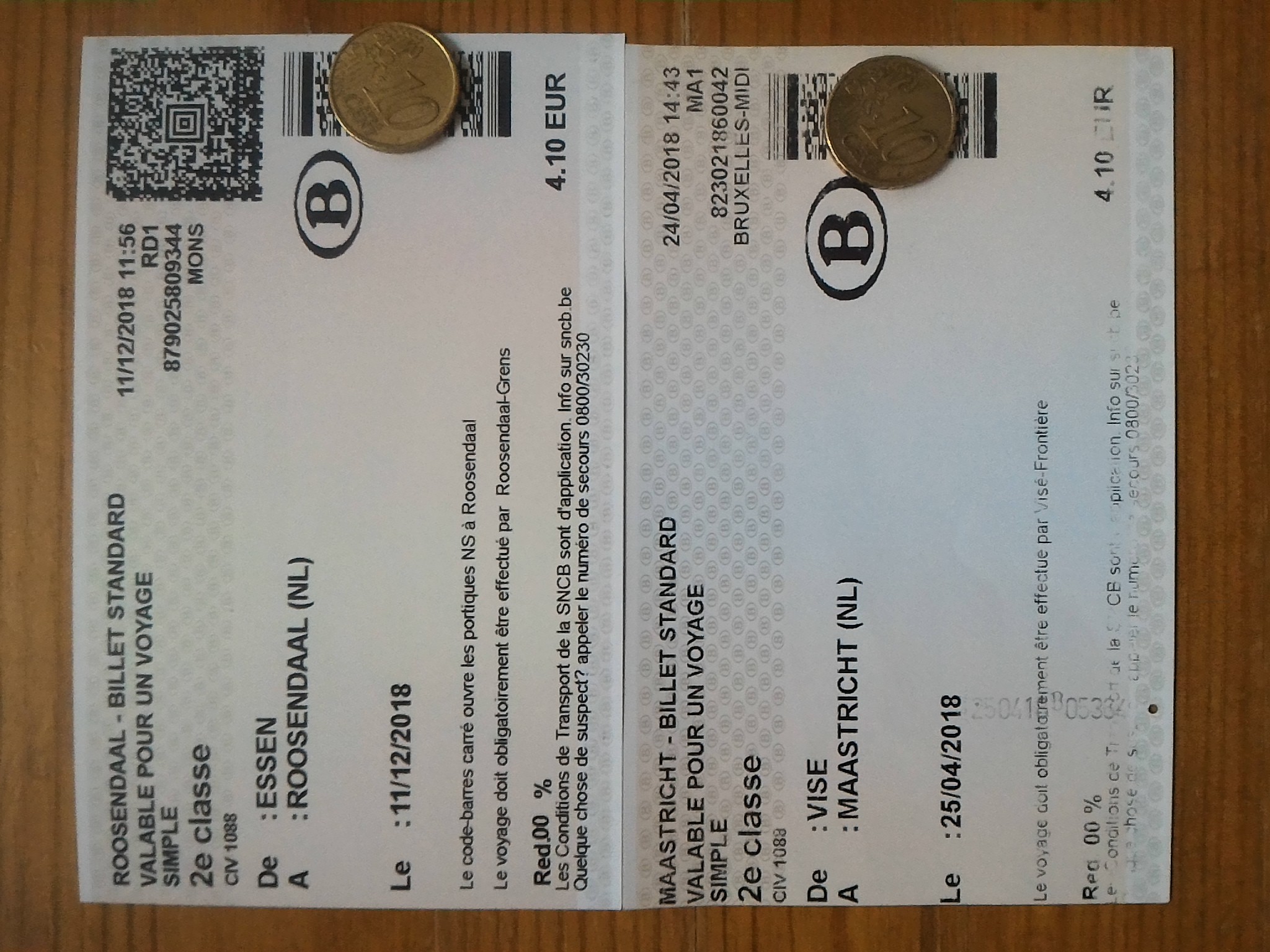
Train deals with England and France
Eurostar and Thalys have their own ticketing (dynamic pricing); see above. When booking through NS International a journey of these plus a connecting (non-high-speed) train journey entirely within the Netherlands, the connecting journey is maximally €9 (second class) or €15 (first class) one-way. The connecting fare is called "Connect Eurostar / Thalys / Nightjet - 2e klas" or "Connect Eurostar / Thalys / Nightjet - 1e klas".
When catching Eurostar, an alternative is catching Eurostar between England and Brussels, and then catch connecting non-high-speed trains between Brussels and the Netherlands. The Netherlands Eurostar website (only in Dutch) gives the option of "Ticket voor Brussel-Zuid + Elk Nederlands station" option as the origin or destination. With this ticket, you can catch a non-high-speed train service between the Netherlands and Brussels on the same day connecting to or from a Eurostar service between Brussels and England. (When heading from the Netherlands to England, make sure that you have enough connection time to go through immigration checks at Brussels.) With this "Connect Eurostar" ticket, the following high-speed trains are NOT included: Thalys, Eurostar Amsterdam – Rotterdam – Brussels, ICE Liège – Brussels. The Intercity direct supplement is exempt. You can cross the Dutch-Belgian border through any of the three frontier points: Visé frontier with Belgian local trains to/from Maastricht, Hazeldonk frontier with Intercity direct/InterCity, or Roosendaal frontier with Belgian local trains to/from Roosendaal.
Make sure that you compare the price of connecting at Brussels versus connecting at Rotterdam/Amsterdam; sometimes the price of Eurostar between London and Rotterdam can be cheaper than between London and Brussles!
The NS International website seems to no longer offer this "Connect Eurostar" fare via Brussels. (When its journey planner offers an itinerary via Brussels, it offers you a usual Netherlands–Belgium ticket for the journey between the Netherlands and Brussels.) However, it is still useful to compare what NS International offers and what Eurostar offers for a Netherlands–England journey.
There are three regular passsenger ferries between the Netherlands and England: Amsterdam IJmuiden – Newcastle upon Tyne, Hoek van Holland – Harwich, Rotterdam Europoort – Kingston upon Hull. Amongst these, the Hoek van Holland – Harwich line has a Rail & Sail deal (from UK, and from NL). This deal includes a single/return ferry journey, plus train travel between Harwich International and any destination in the Abellio Greater Anglia network, e.g. London Liverpool Street (see the Southeastern England rail map). (On the Dutch side, NS and RET have suspended the connecting rail tickets since mid-2020.)
Tourist railroads
The following is a list of rail services in the Netherlands that: a) are tourist-/enthusiast-oriented; b) run 'between destinations' (e.g., not running entirely within a theme park or grounds of a preservation association); and c) run entirely or mostly on railway not served by regular passenger train services. These touristic rail services run on very limited schedules, and they are also relatively expensive. However, you get to experience the history of rail transport, as they usually run on antique vehicles that are difficult to see elsewhere. Excluded in the following list (currently?) are most historical tramways and narrow-gauge railways. Most of the information below is shown in the weekend local train maps above.
Ordinary Dutch railway ticketing (including the OV-chipkaart) is not valid on these services. These services are not aimed at passengers taking luggage with them. Some allow bicycles. Check with the individual organisations.
- In Groningen Province: Museumspoorlijn S•T•A•R, Veendam – Wildervank (– Bareveld) – Stadskanaal; Stadskanaal – Musselkanaal. (A large portion of this trainline is on the border with Drenthe Province.) Steam train rides. Regular train services available at Veendam.
- In Overijssel Province: Museum Buurtspoorweg (MBS), Boekelo – Zoutindustrie – Haaksbergen (southwest of Enschede in Twente Region). Steam train rides. Catch a bus to Haaksbergen (bus 53 from Hengelo is the best).
- In Gelderland Province: Veluwsche Stoomtrein Maatschappij (VSM), Apeldoorn – Beekbergen – Immenbergweg – Loenen – Eerbeek – Dieren. Steam train rides, sometimes boot and old bus rides. Regular train services available at Apeldoorn and Dieren.
- In Limburg Province and Germany: Zuid-Limburgse Stoomtrein Maatschappij (ZLSM) "Miljoenenlijn". Simpelveld – Eys – Wijlre-Gulpen – Schin op Geul (– Valkenburg); Simpelveld – Spekholzerheide – Kerkrade; Simpelveld – Werkplats – Bocholtz – Vetschau (Germany). Steam train and railbus/Schienenbus rides. Regular train service available at Valkenburg, Schin op Geul, and Kerkrade.
- In Noord-Holland Province: Museumstoomtram Hoorn-Medemblik (SHM), Hoorn – Wognum – Twisk – Opperdoes – Medemblik. Steam tram and boat rides. Regular train service available at Hoorn.
- In Noord-Holland Province: Electrische Museumtramlijn Amsterdam (EMA). Amsterdam tram line 30, Haarlemmermeerstation to Bovenkerk.
- In Zuid-Holland and Zeeland Provinces: Stichting voorheen RTM, RTM Remise (– Bezoekerscentrum) – Port Zélande (– Middelplaat Haven) – West Repart. (On Brouwersdam, the western route between Zuid-Holland and Zeeland.) Steam tram, diesel tram, boat rides. Bus 104 Hellevoetsluis (Zuid-Holland) – Renesse (Zeeland) is good for getting to both termini.
- In Zeeland Province: Stichting Stoomtrein Goes - Borsele (SGB), diesel railcars: Goes – 's-Gravenpolder 's-Heer Abtskerke – Nisse – Kwadendamme – Hoedekenskerke – Baarland; steam trains: Goes – Kwadendamme – Hoedekenskerke. Regular train services available at Goes.
Also fun is Het Spoorwegmuseum 'The Railway museum' in Utrecht. Children would love this place. An hourly NS shuttle service runs between Utrecht Centraal and Utrecht Maliebaan on days that the museum opens. It is a normal NS service, and the OV-chipkaart can be used (8 fare-units between Utrecht Centraal and Utrecht Maliebaan). Ordinary modern trains are used for this service. (Walking from Utrecht Centraal takes just a little bit longer than the train ride to Utrecht Maliebaan, but then it is less romantic than catching a train to the Railway Museum...)
Some fun things to do in the Province of Gelderland are:
- Grenzland-Draisine, draisine rides (i.e. it is powered by you the whole way) between Groesbeek and Kranenburg (Germany), and between Kranenburg and Kleve (Germany). Groesbeek is to the southeast of Nijmegen (bus 5), where there are normal Dutch train services. Kranenburg can be reached via bus SB58 between Nijmegen and Kleve, and Kleve has regular German train services (RE 10).
- Openbaar Vervoer & Speelgoed Museum 'Public Transport & Toy Museum' at Doetinchem.
- Transit Oost in Winterswijk.
Disclaimer
I do this as a hobby. I am not a travel agent; while I would be interested in questions that you might have, please direct your questions to the public transport providers involved. Situations and rules can change quickly; please check with the public transport providers for the latest information. I take utter care on the accuracy of the information I provide here, but I cannot be held responsible for any inaccuracies. If you see any doubtful information, comments are welcome: hilario.bambooradical gmail.
Unless otherwise stated, all diagrams, photos, and videos are work of mine. Please respect copyright. I apologise for the quality of the photos and videos; I hope that they are good enough for illustrative purposes.
This page in 2021
Home Be Ne Lux
